Kristine Hughes's Blog, page 101
November 4, 2013
Victoria Visits the Wellington Arch
When we returned to London from our three-day trip -- one each in Cambridge, at Houghton Hall, and at Holkham Hall, I had a busy agenda for the remaining few days of our trip. Poor hubby Ed suffered every day from that very sore foot, aching now in addition to blisters, scrapes and -- well, you get the picture. I always gave him the option of staying put at the hotel, but he stoically limped onward.
Despite the fact that I had visited Apsley House several times, with Kristine, with Pat, my sister-in-law, and others, Ed had never been there. So that was second on my list, just behind the Wellington Arch, which I'd never visited. I'd walked past it plenty of times, but it had not been open before. A bit of web checking told me that the Arch recently opened exhibition space, at that time devoted to a study of the many past and current attempt to SAVE British heritage, particularly by protecting buildings and open spaces.
The Wellington Arch website is here.
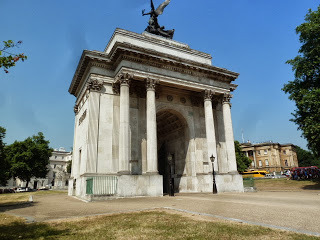
Soapbox alert!!! It doesn't take much beyond a glance at the London skyline to see how contemporary skyscrapers overpower and almost obliterate the beautiful early 20th century view of St. Paul's Dome and the many graceful steeples and spires. Okay, call me a traditionalist (Guilty!) but I wish the powers-that-be could have kept the tall buildings in groups away from the City, Mayfair and Westminster. Alas, it is far too late.
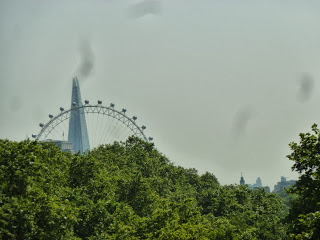 View from the Wellington Arch (including a few stray smudges) I have nothing against tall buildings -- I live in one. But if they had been clustered in various neighborhoods away from the center of London, the beautiful skyline would have been preserved. True of a few cities, Washington, D C for example. No high rises downtown, all clustered in the surrounding communities to preserve the views of the Capitol and other monuments. End of soapbox. Please resume your usual activities.
View from the Wellington Arch (including a few stray smudges) I have nothing against tall buildings -- I live in one. But if they had been clustered in various neighborhoods away from the center of London, the beautiful skyline would have been preserved. True of a few cities, Washington, D C for example. No high rises downtown, all clustered in the surrounding communities to preserve the views of the Capitol and other monuments. End of soapbox. Please resume your usual activities.
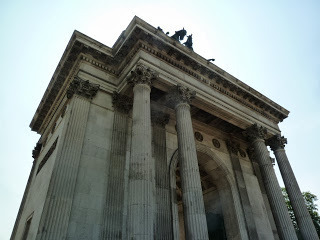 At the height of the Roman Empire, triumphal arches were built to commemorate great events. Think of Rome's Arch of Constantine, the Arch of Titus, and so on. The French started building one in 1806 to mark Napoleon's victory in the Battle of Austerlitz, but it remained unfinished for thirty years, now known as the Arc de Triomphe de l'Etoile in Paris. Not to be outdone, the Prince Regent, later King George IV, wanted to memorialize British victory over France..
At the height of the Roman Empire, triumphal arches were built to commemorate great events. Think of Rome's Arch of Constantine, the Arch of Titus, and so on. The French started building one in 1806 to mark Napoleon's victory in the Battle of Austerlitz, but it remained unfinished for thirty years, now known as the Arc de Triomphe de l'Etoile in Paris. Not to be outdone, the Prince Regent, later King George IV, wanted to memorialize British victory over France..
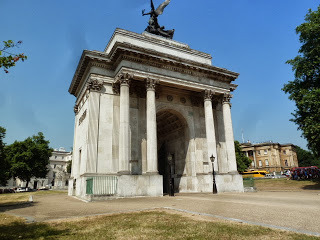 Wellington Arch; Apsley House at the far right Both the Wellington Arch (aka the Green Park Arch and the Constitution Arch) and the Marble Arch were affected by political arguments over cost, design and placement in the 19th century. Both were moved from their original positions and both stand relatively isolated in the middle of traffic circles surrounded by buses, autos, lorries and other noisy vehicles. Traffic too often trumps landscape. Whoops, soapbox again.
Wellington Arch; Apsley House at the far right Both the Wellington Arch (aka the Green Park Arch and the Constitution Arch) and the Marble Arch were affected by political arguments over cost, design and placement in the 19th century. Both were moved from their original positions and both stand relatively isolated in the middle of traffic circles surrounded by buses, autos, lorries and other noisy vehicles. Traffic too often trumps landscape. Whoops, soapbox again.
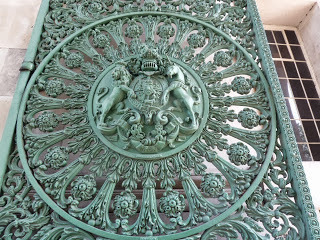 One of the gates, cast in iron by Joseph Bramah and Sons, restored recently The Wellington Arch was designed by Architect Decimus Burton (1800-1881), as his name indicates, the tenth child in his family. He worked with his father, also an architect and John Nash as well. He also designed the Hyde Park screen next to Apsley House.
One of the gates, cast in iron by Joseph Bramah and Sons, restored recently The Wellington Arch was designed by Architect Decimus Burton (1800-1881), as his name indicates, the tenth child in his family. He worked with his father, also an architect and John Nash as well. He also designed the Hyde Park screen next to Apsley House.
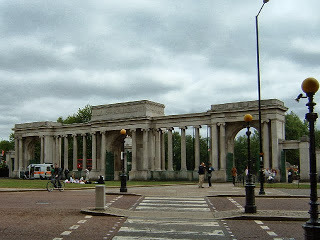 The Hyde Park Screen, 1825
The Hyde Park Screen, 1825
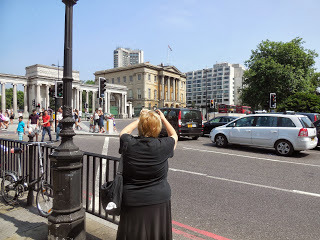 This picture shows the screen in relation to Apsley House; the Wellington is Arch off the picture to the right A few years ago, English Heritage took over the Wellington Arch and changed it from a small police into to a small gift shop with an exhibition space above. There is access to the viewing balcony at the top as well, all by elevator. Ed's sore foot appreciated that particularly!
This picture shows the screen in relation to Apsley House; the Wellington is Arch off the picture to the right A few years ago, English Heritage took over the Wellington Arch and changed it from a small police into to a small gift shop with an exhibition space above. There is access to the viewing balcony at the top as well, all by elevator. Ed's sore foot appreciated that particularly!
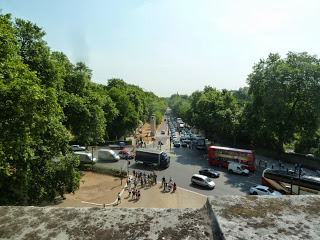 View down Constitution Hill towards Buckingham Palace
View down Constitution Hill towards Buckingham Palace
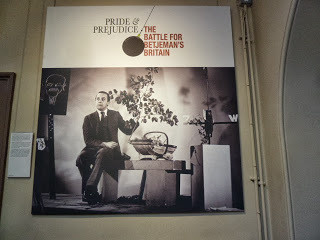 The Exhibition: Pride and Prejudice: The Battle for Betjeman's Britain John Betjeman (1906-1984) was Britain's Poet Laureate in addition to being a popular radio and tv commentator and an avid campaigner for the protection of architectural heritage. Below, the maquette for his statue located in St. Pancras Station, one of the buildings he successfully fought to save.
The Exhibition: Pride and Prejudice: The Battle for Betjeman's Britain John Betjeman (1906-1984) was Britain's Poet Laureate in addition to being a popular radio and tv commentator and an avid campaigner for the protection of architectural heritage. Below, the maquette for his statue located in St. Pancras Station, one of the buildings he successfully fought to save.
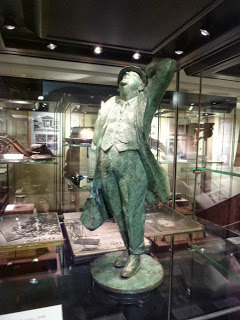 John Betjeman (maquette) by sculptor Martin Jennings, 2006
John Betjeman (maquette) by sculptor Martin Jennings, 2006
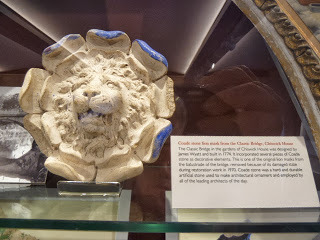 Coade Stone Lion Mask The rosette above came from the Classic Bridge at Chiswick, designed by James Wyatt in 1774; Coade Stone is artificial, often used by leading architects for statues and ornaments.
Coade Stone Lion Mask The rosette above came from the Classic Bridge at Chiswick, designed by James Wyatt in 1774; Coade Stone is artificial, often used by leading architects for statues and ornaments.
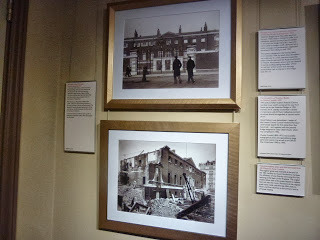 Devonshire House, before and during demolition For more information on this exhibition, click here A group hoping to honor the Duke of Wellington erected a gigantic equestrian statue on top of the arch in 1846. Being out of all proportion to the arch, the statue caused great criticism and even laughter.
Devonshire House, before and during demolition For more information on this exhibition, click here A group hoping to honor the Duke of Wellington erected a gigantic equestrian statue on top of the arch in 1846. Being out of all proportion to the arch, the statue caused great criticism and even laughter.
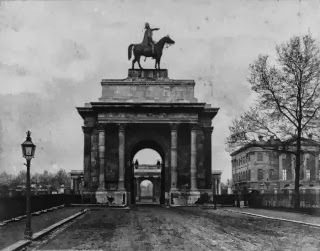 view, about 1860 In 1882-83, The arch was dismantled and rebuilt in its present traffic-bound position. The Statue was moved to Aldershot (after much discussion) where it can be seen today. A few years later, in 1899, Adrian Jones (1845-1938) designed the Quadriga, four horses driven by a boy and crowned by the Angel of Peace. It was completed in 1912.
view, about 1860 In 1882-83, The arch was dismantled and rebuilt in its present traffic-bound position. The Statue was moved to Aldershot (after much discussion) where it can be seen today. A few years later, in 1899, Adrian Jones (1845-1938) designed the Quadriga, four horses driven by a boy and crowned by the Angel of Peace. It was completed in 1912.
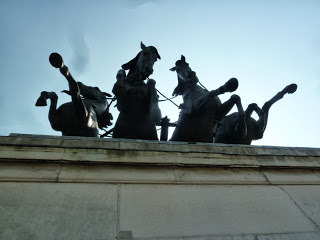
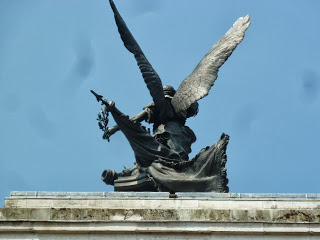 From the front and from the back
From the front and from the back
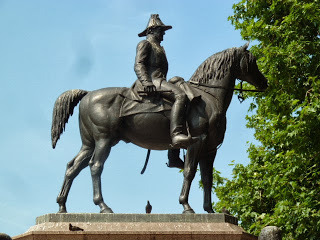 Wellington on Copenhagen holding his telescope Erected in 1888, the statue on the Arch grounds, across the road from Apsley House, was sculpted and cast in bronze by Sir Joseph Edgar Boehm (1834-1890). Boehm was a favorite artist of the royal family and a teacher of sculptress Princess Louise, Duchess of Argyll (1848-1939), Queen Victoria's fourth daughter.
Wellington on Copenhagen holding his telescope Erected in 1888, the statue on the Arch grounds, across the road from Apsley House, was sculpted and cast in bronze by Sir Joseph Edgar Boehm (1834-1890). Boehm was a favorite artist of the royal family and a teacher of sculptress Princess Louise, Duchess of Argyll (1848-1939), Queen Victoria's fourth daughter.
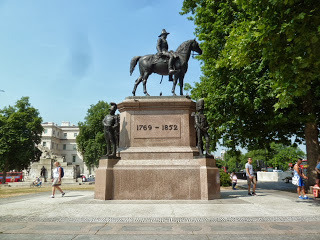 The figures at the four corners of the red granite plinth are guardsmen from Wellington's troops: a Grenadier, a Welsh Fusilier, a Royal Highlander, and an Inniskilling Dragoon.
The figures at the four corners of the red granite plinth are guardsmen from Wellington's troops: a Grenadier, a Welsh Fusilier, a Royal Highlander, and an Inniskilling Dragoon.
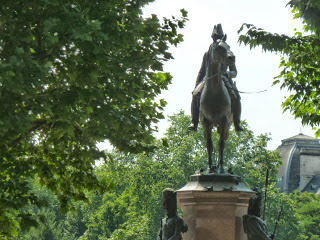 As I mentioned before, the Wellington Arch and the equestrian statue stand in the middle of a traffic circle, joined to the adjacent streets and the Hyde Park Corner Tube stop by underground walkways. The white tile walls are decorated with scenes of Wellington and his troops. Below, a few examples as we walked -- or I walked and Ed limped -- to visit Apsley House.
As I mentioned before, the Wellington Arch and the equestrian statue stand in the middle of a traffic circle, joined to the adjacent streets and the Hyde Park Corner Tube stop by underground walkways. The white tile walls are decorated with scenes of Wellington and his troops. Below, a few examples as we walked -- or I walked and Ed limped -- to visit Apsley House.
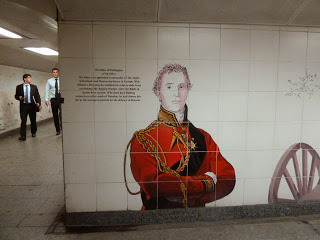
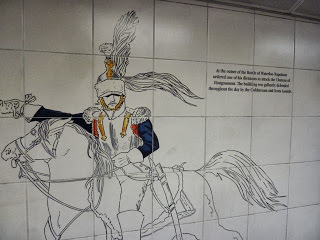
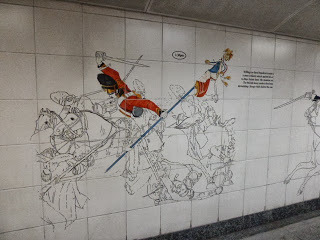
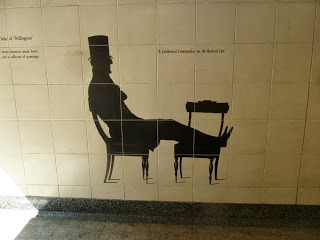
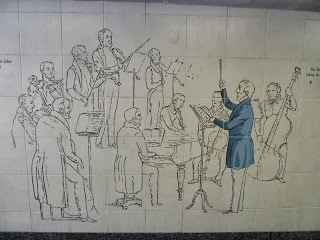
Next, Victoria and Ed visit Apsley House
Despite the fact that I had visited Apsley House several times, with Kristine, with Pat, my sister-in-law, and others, Ed had never been there. So that was second on my list, just behind the Wellington Arch, which I'd never visited. I'd walked past it plenty of times, but it had not been open before. A bit of web checking told me that the Arch recently opened exhibition space, at that time devoted to a study of the many past and current attempt to SAVE British heritage, particularly by protecting buildings and open spaces.
The Wellington Arch website is here.

Soapbox alert!!! It doesn't take much beyond a glance at the London skyline to see how contemporary skyscrapers overpower and almost obliterate the beautiful early 20th century view of St. Paul's Dome and the many graceful steeples and spires. Okay, call me a traditionalist (Guilty!) but I wish the powers-that-be could have kept the tall buildings in groups away from the City, Mayfair and Westminster. Alas, it is far too late.
 View from the Wellington Arch (including a few stray smudges) I have nothing against tall buildings -- I live in one. But if they had been clustered in various neighborhoods away from the center of London, the beautiful skyline would have been preserved. True of a few cities, Washington, D C for example. No high rises downtown, all clustered in the surrounding communities to preserve the views of the Capitol and other monuments. End of soapbox. Please resume your usual activities.
View from the Wellington Arch (including a few stray smudges) I have nothing against tall buildings -- I live in one. But if they had been clustered in various neighborhoods away from the center of London, the beautiful skyline would have been preserved. True of a few cities, Washington, D C for example. No high rises downtown, all clustered in the surrounding communities to preserve the views of the Capitol and other monuments. End of soapbox. Please resume your usual activities.
 At the height of the Roman Empire, triumphal arches were built to commemorate great events. Think of Rome's Arch of Constantine, the Arch of Titus, and so on. The French started building one in 1806 to mark Napoleon's victory in the Battle of Austerlitz, but it remained unfinished for thirty years, now known as the Arc de Triomphe de l'Etoile in Paris. Not to be outdone, the Prince Regent, later King George IV, wanted to memorialize British victory over France..
At the height of the Roman Empire, triumphal arches were built to commemorate great events. Think of Rome's Arch of Constantine, the Arch of Titus, and so on. The French started building one in 1806 to mark Napoleon's victory in the Battle of Austerlitz, but it remained unfinished for thirty years, now known as the Arc de Triomphe de l'Etoile in Paris. Not to be outdone, the Prince Regent, later King George IV, wanted to memorialize British victory over France..
 Wellington Arch; Apsley House at the far right Both the Wellington Arch (aka the Green Park Arch and the Constitution Arch) and the Marble Arch were affected by political arguments over cost, design and placement in the 19th century. Both were moved from their original positions and both stand relatively isolated in the middle of traffic circles surrounded by buses, autos, lorries and other noisy vehicles. Traffic too often trumps landscape. Whoops, soapbox again.
Wellington Arch; Apsley House at the far right Both the Wellington Arch (aka the Green Park Arch and the Constitution Arch) and the Marble Arch were affected by political arguments over cost, design and placement in the 19th century. Both were moved from their original positions and both stand relatively isolated in the middle of traffic circles surrounded by buses, autos, lorries and other noisy vehicles. Traffic too often trumps landscape. Whoops, soapbox again.
 One of the gates, cast in iron by Joseph Bramah and Sons, restored recently The Wellington Arch was designed by Architect Decimus Burton (1800-1881), as his name indicates, the tenth child in his family. He worked with his father, also an architect and John Nash as well. He also designed the Hyde Park screen next to Apsley House.
One of the gates, cast in iron by Joseph Bramah and Sons, restored recently The Wellington Arch was designed by Architect Decimus Burton (1800-1881), as his name indicates, the tenth child in his family. He worked with his father, also an architect and John Nash as well. He also designed the Hyde Park screen next to Apsley House.
 The Hyde Park Screen, 1825
The Hyde Park Screen, 1825
 This picture shows the screen in relation to Apsley House; the Wellington is Arch off the picture to the right A few years ago, English Heritage took over the Wellington Arch and changed it from a small police into to a small gift shop with an exhibition space above. There is access to the viewing balcony at the top as well, all by elevator. Ed's sore foot appreciated that particularly!
This picture shows the screen in relation to Apsley House; the Wellington is Arch off the picture to the right A few years ago, English Heritage took over the Wellington Arch and changed it from a small police into to a small gift shop with an exhibition space above. There is access to the viewing balcony at the top as well, all by elevator. Ed's sore foot appreciated that particularly!
 View down Constitution Hill towards Buckingham Palace
View down Constitution Hill towards Buckingham Palace
 The Exhibition: Pride and Prejudice: The Battle for Betjeman's Britain John Betjeman (1906-1984) was Britain's Poet Laureate in addition to being a popular radio and tv commentator and an avid campaigner for the protection of architectural heritage. Below, the maquette for his statue located in St. Pancras Station, one of the buildings he successfully fought to save.
The Exhibition: Pride and Prejudice: The Battle for Betjeman's Britain John Betjeman (1906-1984) was Britain's Poet Laureate in addition to being a popular radio and tv commentator and an avid campaigner for the protection of architectural heritage. Below, the maquette for his statue located in St. Pancras Station, one of the buildings he successfully fought to save.
 John Betjeman (maquette) by sculptor Martin Jennings, 2006
John Betjeman (maquette) by sculptor Martin Jennings, 2006
 Coade Stone Lion Mask The rosette above came from the Classic Bridge at Chiswick, designed by James Wyatt in 1774; Coade Stone is artificial, often used by leading architects for statues and ornaments.
Coade Stone Lion Mask The rosette above came from the Classic Bridge at Chiswick, designed by James Wyatt in 1774; Coade Stone is artificial, often used by leading architects for statues and ornaments.
 Devonshire House, before and during demolition For more information on this exhibition, click here A group hoping to honor the Duke of Wellington erected a gigantic equestrian statue on top of the arch in 1846. Being out of all proportion to the arch, the statue caused great criticism and even laughter.
Devonshire House, before and during demolition For more information on this exhibition, click here A group hoping to honor the Duke of Wellington erected a gigantic equestrian statue on top of the arch in 1846. Being out of all proportion to the arch, the statue caused great criticism and even laughter.
 view, about 1860 In 1882-83, The arch was dismantled and rebuilt in its present traffic-bound position. The Statue was moved to Aldershot (after much discussion) where it can be seen today. A few years later, in 1899, Adrian Jones (1845-1938) designed the Quadriga, four horses driven by a boy and crowned by the Angel of Peace. It was completed in 1912.
view, about 1860 In 1882-83, The arch was dismantled and rebuilt in its present traffic-bound position. The Statue was moved to Aldershot (after much discussion) where it can be seen today. A few years later, in 1899, Adrian Jones (1845-1938) designed the Quadriga, four horses driven by a boy and crowned by the Angel of Peace. It was completed in 1912.

 From the front and from the back
From the front and from the back
 Wellington on Copenhagen holding his telescope Erected in 1888, the statue on the Arch grounds, across the road from Apsley House, was sculpted and cast in bronze by Sir Joseph Edgar Boehm (1834-1890). Boehm was a favorite artist of the royal family and a teacher of sculptress Princess Louise, Duchess of Argyll (1848-1939), Queen Victoria's fourth daughter.
Wellington on Copenhagen holding his telescope Erected in 1888, the statue on the Arch grounds, across the road from Apsley House, was sculpted and cast in bronze by Sir Joseph Edgar Boehm (1834-1890). Boehm was a favorite artist of the royal family and a teacher of sculptress Princess Louise, Duchess of Argyll (1848-1939), Queen Victoria's fourth daughter. The figures at the four corners of the red granite plinth are guardsmen from Wellington's troops: a Grenadier, a Welsh Fusilier, a Royal Highlander, and an Inniskilling Dragoon.
The figures at the four corners of the red granite plinth are guardsmen from Wellington's troops: a Grenadier, a Welsh Fusilier, a Royal Highlander, and an Inniskilling Dragoon.
 As I mentioned before, the Wellington Arch and the equestrian statue stand in the middle of a traffic circle, joined to the adjacent streets and the Hyde Park Corner Tube stop by underground walkways. The white tile walls are decorated with scenes of Wellington and his troops. Below, a few examples as we walked -- or I walked and Ed limped -- to visit Apsley House.
As I mentioned before, the Wellington Arch and the equestrian statue stand in the middle of a traffic circle, joined to the adjacent streets and the Hyde Park Corner Tube stop by underground walkways. The white tile walls are decorated with scenes of Wellington and his troops. Below, a few examples as we walked -- or I walked and Ed limped -- to visit Apsley House.





Next, Victoria and Ed visit Apsley House
Published on November 04, 2013 00:30
November 1, 2013
The Magnificent Waterloo Chamber: The Wellington Tour
Victoria here, inviting you to join Kristine and me on The Wellington Tour, 4-14 September, 2014. For details on our planned itinerary, costs and other info, click here. Among the features of the tour is a visit to Windsor Castle and especially to its Waterloo Chamber.
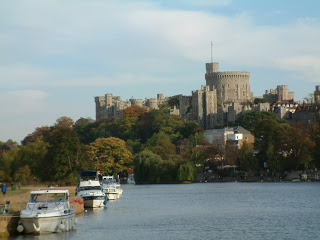 Windsor Castle from the Thames The Waterloo Chamber was constructed within the Castle to commemorate the victory of the Allied Armies over the French in the Battle of Waterloo, June 18, 1815. Architect Sir Jeffry Wyattville (1766 – 1840) created the Chamber in 1824 out of several existing rooms. Parliament designated £300,000 for the project. Like most of King George IV's inspirations, it ran well over budget, eventually costing about £1,000,000. Wyattville also remodeled many other areas of Windsor Castle for George IV, William IV, and Queen Victoria; he was buried in the Castle's St. George's Chapel in 1840.
Windsor Castle from the Thames The Waterloo Chamber was constructed within the Castle to commemorate the victory of the Allied Armies over the French in the Battle of Waterloo, June 18, 1815. Architect Sir Jeffry Wyattville (1766 – 1840) created the Chamber in 1824 out of several existing rooms. Parliament designated £300,000 for the project. Like most of King George IV's inspirations, it ran well over budget, eventually costing about £1,000,000. Wyattville also remodeled many other areas of Windsor Castle for George IV, William IV, and Queen Victoria; he was buried in the Castle's St. George's Chapel in 1840.
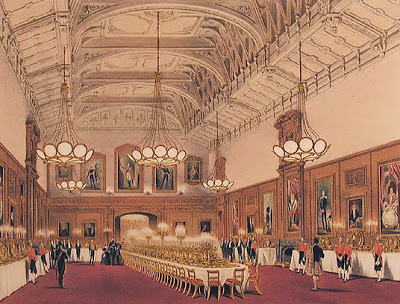 Watercolour of the Waterloo Chamber in 1844 by Joseph Nash
Watercolour of the Waterloo Chamber in 1844 by Joseph Nash
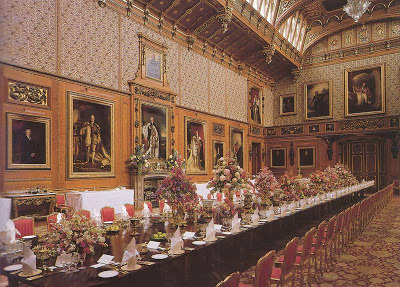 Waterloo Chamber, currently For a virtual tour of the entire Waterloo Chamber, click here.
Waterloo Chamber, currently For a virtual tour of the entire Waterloo Chamber, click here.
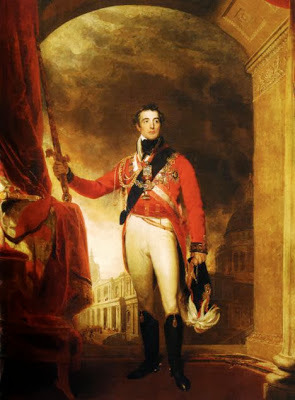 Arthur Wellesley, 1st Duke of WellingtonCommander of the Victorious Allied Armies The walls of the Waterloo Chamber are filled with large portraits of the leaders of the Allied efforts. Most of them are painted by Sir Thomas Lawrence (1769-1830), the Regency era's favorite artist. Many were reproduced several times by his studio for numerous placements in other palaces, stately homes and distinguished galleries.
Arthur Wellesley, 1st Duke of WellingtonCommander of the Victorious Allied Armies The walls of the Waterloo Chamber are filled with large portraits of the leaders of the Allied efforts. Most of them are painted by Sir Thomas Lawrence (1769-1830), the Regency era's favorite artist. Many were reproduced several times by his studio for numerous placements in other palaces, stately homes and distinguished galleries.
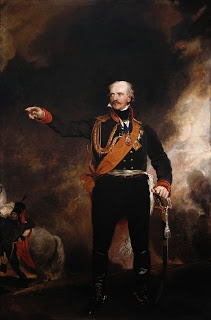 Prussian General Gebhardt von BlücherWellington's Comrade-in-arms at WaterlooSir Thomas Lawrence 1816 The Prince Regent (later George IV) commissioned Lawrence to paint all the Allied Sovereigns, military leaders, and statesmen. Lawrence traveled around Europe to complete the portraits.
Prussian General Gebhardt von BlücherWellington's Comrade-in-arms at WaterlooSir Thomas Lawrence 1816 The Prince Regent (later George IV) commissioned Lawrence to paint all the Allied Sovereigns, military leaders, and statesmen. Lawrence traveled around Europe to complete the portraits.
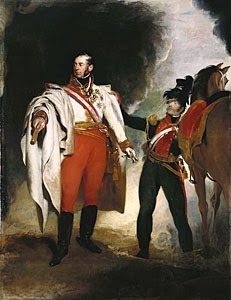 Austrian Field Marshal Karl Philipp, Prince of Schwartzenberg,
Austrian Field Marshal Karl Philipp, Prince of Schwartzenberg,
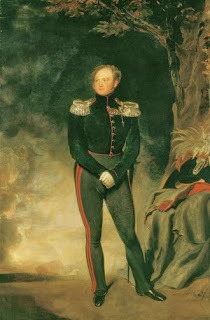 Alexander I, Emperor of Russia (1777-1825)painted by Sir Thomas Lawrence, 1818 According to the Royal Collection Website, "While working on the portrait Lawrence altered the position of the legs, much to the consternation of the Tzar and those courtiers attending the portrait sitting, especially when for a while the sitter was shown with four legs." Obviously, this condition was corrected!
Alexander I, Emperor of Russia (1777-1825)painted by Sir Thomas Lawrence, 1818 According to the Royal Collection Website, "While working on the portrait Lawrence altered the position of the legs, much to the consternation of the Tzar and those courtiers attending the portrait sitting, especially when for a while the sitter was shown with four legs." Obviously, this condition was corrected!
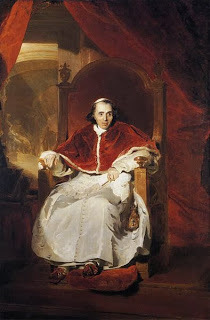 Pope Pius VII, 1819-20 The portrait of Pope Pius VII (1742-1823), painted in Rome, is widely agreed to be Lawrence's masterpiece, both incisive and sympathetic. While heads of state and leading generals were depicted full length, politicians and statesmen were honored with 3/4 length portraits, perhaps putting them in their place?
Pope Pius VII, 1819-20 The portrait of Pope Pius VII (1742-1823), painted in Rome, is widely agreed to be Lawrence's masterpiece, both incisive and sympathetic. While heads of state and leading generals were depicted full length, politicians and statesmen were honored with 3/4 length portraits, perhaps putting them in their place?
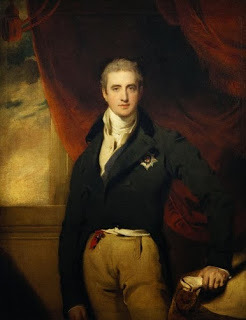 Viscount CastlereaghSir Thomas Lawrence, 1830 Robert Stewart (1769-1822), Viscount Castlereagh, later second Marquess of Londonderry, served as Secretary of State for War 1805-09, and Foreign Secretary 1812-1822
Viscount CastlereaghSir Thomas Lawrence, 1830 Robert Stewart (1769-1822), Viscount Castlereagh, later second Marquess of Londonderry, served as Secretary of State for War 1805-09, and Foreign Secretary 1812-1822
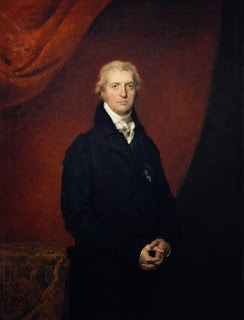 Robert Banks Jenkinson, 2nd Earl of Liverpool Robert Banks Jenkinson (1770-1828), 2nd Earl of Liverpool was Prime Minister from 1812 to 1827, and also preceded the Duke of Wellington as the Lord Warden of the Cinque Ports, about which more soon!! In the words of the Windsor Castle guidebook, "Most of the twenty eight portraits were delivered after his [Lawrence's] death on 7 January 1830. By this time work was already begun of the space of the Waterloo Chamber created by covering a courtyard at Windsor Castle with a huge sky-lit vault; the room was completed during the reign of William IV (1830-7)...the arrangement which survives to this day: full-length portraits of warriors hang high, over the two end balconies and around the walls; at ground level full-length portraits of monarchs alternate with half-lengths of diplomats and statesmen."
Robert Banks Jenkinson, 2nd Earl of Liverpool Robert Banks Jenkinson (1770-1828), 2nd Earl of Liverpool was Prime Minister from 1812 to 1827, and also preceded the Duke of Wellington as the Lord Warden of the Cinque Ports, about which more soon!! In the words of the Windsor Castle guidebook, "Most of the twenty eight portraits were delivered after his [Lawrence's] death on 7 January 1830. By this time work was already begun of the space of the Waterloo Chamber created by covering a courtyard at Windsor Castle with a huge sky-lit vault; the room was completed during the reign of William IV (1830-7)...the arrangement which survives to this day: full-length portraits of warriors hang high, over the two end balconies and around the walls; at ground level full-length portraits of monarchs alternate with half-lengths of diplomats and statesmen."
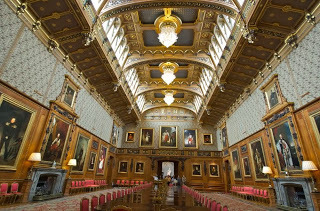 The limewood carvings on the walls were removed from the former Royal Chapel before it was demolished in the 1820s. The carvings date from the 1680's, the work of renowned artist Grinling Gibbons. According to the Castle Guidebook, "The Indian carpet was woven for this room by the inmates of Agra prison for Queen Victoria’s Golden Jubilee, finally reaching Windsor in 1894. Thought to be the largest seamless carpet in existence, it weighs two tonnes. During the 1992 fire it took 50 soldiers to roll it up and move it to safety." Which brings up a sorrowful subject, the terrible fire of eleven years ago.
The limewood carvings on the walls were removed from the former Royal Chapel before it was demolished in the 1820s. The carvings date from the 1680's, the work of renowned artist Grinling Gibbons. According to the Castle Guidebook, "The Indian carpet was woven for this room by the inmates of Agra prison for Queen Victoria’s Golden Jubilee, finally reaching Windsor in 1894. Thought to be the largest seamless carpet in existence, it weighs two tonnes. During the 1992 fire it took 50 soldiers to roll it up and move it to safety." Which brings up a sorrowful subject, the terrible fire of eleven years ago.
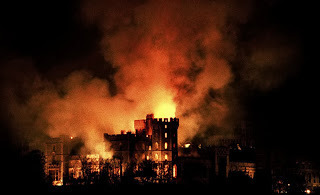 20 November, 1992 Extensive damage resulted from the fire though the Waterloo Chamber was only slightly damaged, due to the thickness of the walls. Other areas were destroyed and eventually repaired. To pay for the £36.5 million repairs, the Queen opened the State Rooms of Buckingham Palace to the Public, but only when she is in residence elsewhere. When you tour Windsor Castle with Kristine and me, you will see the renovated areas and where the fire burned. And we will view the Waterloo Chamber -- and all the State rooms, most of them still very much as they were when redone for George IV by Sir Jeffry Wyattville. Again to access more information on the Wellington Tour, go to http://wellingtontour.blogspot.com/
20 November, 1992 Extensive damage resulted from the fire though the Waterloo Chamber was only slightly damaged, due to the thickness of the walls. Other areas were destroyed and eventually repaired. To pay for the £36.5 million repairs, the Queen opened the State Rooms of Buckingham Palace to the Public, but only when she is in residence elsewhere. When you tour Windsor Castle with Kristine and me, you will see the renovated areas and where the fire burned. And we will view the Waterloo Chamber -- and all the State rooms, most of them still very much as they were when redone for George IV by Sir Jeffry Wyattville. Again to access more information on the Wellington Tour, go to http://wellingtontour.blogspot.com/
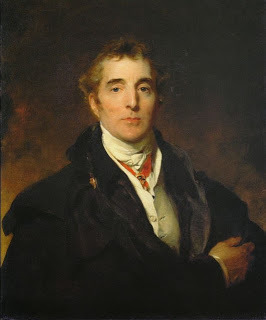
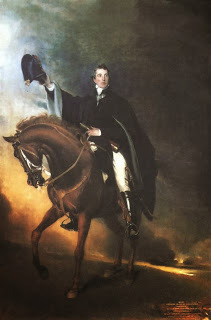 .
.
 Windsor Castle from the Thames The Waterloo Chamber was constructed within the Castle to commemorate the victory of the Allied Armies over the French in the Battle of Waterloo, June 18, 1815. Architect Sir Jeffry Wyattville (1766 – 1840) created the Chamber in 1824 out of several existing rooms. Parliament designated £300,000 for the project. Like most of King George IV's inspirations, it ran well over budget, eventually costing about £1,000,000. Wyattville also remodeled many other areas of Windsor Castle for George IV, William IV, and Queen Victoria; he was buried in the Castle's St. George's Chapel in 1840.
Windsor Castle from the Thames The Waterloo Chamber was constructed within the Castle to commemorate the victory of the Allied Armies over the French in the Battle of Waterloo, June 18, 1815. Architect Sir Jeffry Wyattville (1766 – 1840) created the Chamber in 1824 out of several existing rooms. Parliament designated £300,000 for the project. Like most of King George IV's inspirations, it ran well over budget, eventually costing about £1,000,000. Wyattville also remodeled many other areas of Windsor Castle for George IV, William IV, and Queen Victoria; he was buried in the Castle's St. George's Chapel in 1840.
 Watercolour of the Waterloo Chamber in 1844 by Joseph Nash
Watercolour of the Waterloo Chamber in 1844 by Joseph Nash
 Waterloo Chamber, currently For a virtual tour of the entire Waterloo Chamber, click here.
Waterloo Chamber, currently For a virtual tour of the entire Waterloo Chamber, click here.
 Arthur Wellesley, 1st Duke of WellingtonCommander of the Victorious Allied Armies The walls of the Waterloo Chamber are filled with large portraits of the leaders of the Allied efforts. Most of them are painted by Sir Thomas Lawrence (1769-1830), the Regency era's favorite artist. Many were reproduced several times by his studio for numerous placements in other palaces, stately homes and distinguished galleries.
Arthur Wellesley, 1st Duke of WellingtonCommander of the Victorious Allied Armies The walls of the Waterloo Chamber are filled with large portraits of the leaders of the Allied efforts. Most of them are painted by Sir Thomas Lawrence (1769-1830), the Regency era's favorite artist. Many were reproduced several times by his studio for numerous placements in other palaces, stately homes and distinguished galleries.
 Prussian General Gebhardt von BlücherWellington's Comrade-in-arms at WaterlooSir Thomas Lawrence 1816 The Prince Regent (later George IV) commissioned Lawrence to paint all the Allied Sovereigns, military leaders, and statesmen. Lawrence traveled around Europe to complete the portraits.
Prussian General Gebhardt von BlücherWellington's Comrade-in-arms at WaterlooSir Thomas Lawrence 1816 The Prince Regent (later George IV) commissioned Lawrence to paint all the Allied Sovereigns, military leaders, and statesmen. Lawrence traveled around Europe to complete the portraits.
 Austrian Field Marshal Karl Philipp, Prince of Schwartzenberg,
Austrian Field Marshal Karl Philipp, Prince of Schwartzenberg,
 Alexander I, Emperor of Russia (1777-1825)painted by Sir Thomas Lawrence, 1818 According to the Royal Collection Website, "While working on the portrait Lawrence altered the position of the legs, much to the consternation of the Tzar and those courtiers attending the portrait sitting, especially when for a while the sitter was shown with four legs." Obviously, this condition was corrected!
Alexander I, Emperor of Russia (1777-1825)painted by Sir Thomas Lawrence, 1818 According to the Royal Collection Website, "While working on the portrait Lawrence altered the position of the legs, much to the consternation of the Tzar and those courtiers attending the portrait sitting, especially when for a while the sitter was shown with four legs." Obviously, this condition was corrected!
 Pope Pius VII, 1819-20 The portrait of Pope Pius VII (1742-1823), painted in Rome, is widely agreed to be Lawrence's masterpiece, both incisive and sympathetic. While heads of state and leading generals were depicted full length, politicians and statesmen were honored with 3/4 length portraits, perhaps putting them in their place?
Pope Pius VII, 1819-20 The portrait of Pope Pius VII (1742-1823), painted in Rome, is widely agreed to be Lawrence's masterpiece, both incisive and sympathetic. While heads of state and leading generals were depicted full length, politicians and statesmen were honored with 3/4 length portraits, perhaps putting them in their place?
 Viscount CastlereaghSir Thomas Lawrence, 1830 Robert Stewart (1769-1822), Viscount Castlereagh, later second Marquess of Londonderry, served as Secretary of State for War 1805-09, and Foreign Secretary 1812-1822
Viscount CastlereaghSir Thomas Lawrence, 1830 Robert Stewart (1769-1822), Viscount Castlereagh, later second Marquess of Londonderry, served as Secretary of State for War 1805-09, and Foreign Secretary 1812-1822
 Robert Banks Jenkinson, 2nd Earl of Liverpool Robert Banks Jenkinson (1770-1828), 2nd Earl of Liverpool was Prime Minister from 1812 to 1827, and also preceded the Duke of Wellington as the Lord Warden of the Cinque Ports, about which more soon!! In the words of the Windsor Castle guidebook, "Most of the twenty eight portraits were delivered after his [Lawrence's] death on 7 January 1830. By this time work was already begun of the space of the Waterloo Chamber created by covering a courtyard at Windsor Castle with a huge sky-lit vault; the room was completed during the reign of William IV (1830-7)...the arrangement which survives to this day: full-length portraits of warriors hang high, over the two end balconies and around the walls; at ground level full-length portraits of monarchs alternate with half-lengths of diplomats and statesmen."
Robert Banks Jenkinson, 2nd Earl of Liverpool Robert Banks Jenkinson (1770-1828), 2nd Earl of Liverpool was Prime Minister from 1812 to 1827, and also preceded the Duke of Wellington as the Lord Warden of the Cinque Ports, about which more soon!! In the words of the Windsor Castle guidebook, "Most of the twenty eight portraits were delivered after his [Lawrence's] death on 7 January 1830. By this time work was already begun of the space of the Waterloo Chamber created by covering a courtyard at Windsor Castle with a huge sky-lit vault; the room was completed during the reign of William IV (1830-7)...the arrangement which survives to this day: full-length portraits of warriors hang high, over the two end balconies and around the walls; at ground level full-length portraits of monarchs alternate with half-lengths of diplomats and statesmen."
 The limewood carvings on the walls were removed from the former Royal Chapel before it was demolished in the 1820s. The carvings date from the 1680's, the work of renowned artist Grinling Gibbons. According to the Castle Guidebook, "The Indian carpet was woven for this room by the inmates of Agra prison for Queen Victoria’s Golden Jubilee, finally reaching Windsor in 1894. Thought to be the largest seamless carpet in existence, it weighs two tonnes. During the 1992 fire it took 50 soldiers to roll it up and move it to safety." Which brings up a sorrowful subject, the terrible fire of eleven years ago.
The limewood carvings on the walls were removed from the former Royal Chapel before it was demolished in the 1820s. The carvings date from the 1680's, the work of renowned artist Grinling Gibbons. According to the Castle Guidebook, "The Indian carpet was woven for this room by the inmates of Agra prison for Queen Victoria’s Golden Jubilee, finally reaching Windsor in 1894. Thought to be the largest seamless carpet in existence, it weighs two tonnes. During the 1992 fire it took 50 soldiers to roll it up and move it to safety." Which brings up a sorrowful subject, the terrible fire of eleven years ago.
 20 November, 1992 Extensive damage resulted from the fire though the Waterloo Chamber was only slightly damaged, due to the thickness of the walls. Other areas were destroyed and eventually repaired. To pay for the £36.5 million repairs, the Queen opened the State Rooms of Buckingham Palace to the Public, but only when she is in residence elsewhere. When you tour Windsor Castle with Kristine and me, you will see the renovated areas and where the fire burned. And we will view the Waterloo Chamber -- and all the State rooms, most of them still very much as they were when redone for George IV by Sir Jeffry Wyattville. Again to access more information on the Wellington Tour, go to http://wellingtontour.blogspot.com/
20 November, 1992 Extensive damage resulted from the fire though the Waterloo Chamber was only slightly damaged, due to the thickness of the walls. Other areas were destroyed and eventually repaired. To pay for the £36.5 million repairs, the Queen opened the State Rooms of Buckingham Palace to the Public, but only when she is in residence elsewhere. When you tour Windsor Castle with Kristine and me, you will see the renovated areas and where the fire burned. And we will view the Waterloo Chamber -- and all the State rooms, most of them still very much as they were when redone for George IV by Sir Jeffry Wyattville. Again to access more information on the Wellington Tour, go to http://wellingtontour.blogspot.com/

 .
.
Published on November 01, 2013 00:30
October 30, 2013
At the King's Table by Susanne Groom
Victoria here, reporting on a meeting I attended recently at Chicago's Newberry Library. Cosponsored by the Royal Oak Foundation, the U.S. support group for Britain's National Trust, and Historic Royal Palaces Inc., I met my pal Susan Forgue to hear Suzanne Groom speak about her new book, At the King's Table.
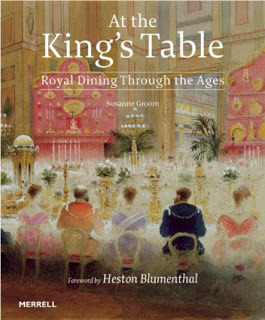 In addition to many other activities, the Royal Oak Foundation brings speakers to various cities around the U.S. for fascinating illustrated lectures. To learn more about the Royal Oak Foundation, click here. Historic Royal Palaces website is here. And, to complete the picture, click here for the Newberry Library website.
In addition to many other activities, the Royal Oak Foundation brings speakers to various cities around the U.S. for fascinating illustrated lectures. To learn more about the Royal Oak Foundation, click here. Historic Royal Palaces website is here. And, to complete the picture, click here for the Newberry Library website.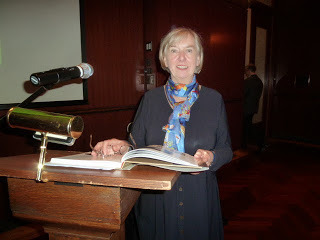 Suzanne Groom, author of At the King's Table
Suzanne Groom, author of At the King's Table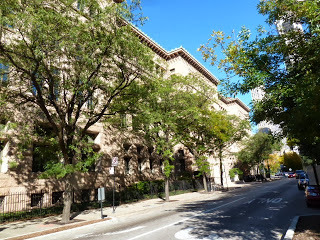 The Newberry Library in October Ms. Groom spent 25 years with Historic Royal Palaces, working at projects at Hampton Court, the Banqueting House and Kew Palace. Her account, beautifully illustrated, of the feasts held by the Kings of England, goes back to William the Conqueror. I cannot begin to reproduce all her fascinating stories of Royal Banquets, but I can recount a few. You will find much, much more in the book.
The Newberry Library in October Ms. Groom spent 25 years with Historic Royal Palaces, working at projects at Hampton Court, the Banqueting House and Kew Palace. Her account, beautifully illustrated, of the feasts held by the Kings of England, goes back to William the Conqueror. I cannot begin to reproduce all her fascinating stories of Royal Banquets, but I can recount a few. You will find much, much more in the book.
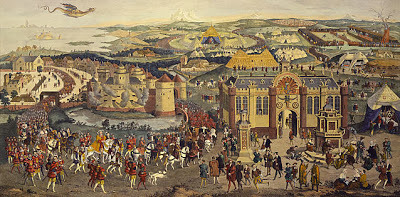 The Field of Cloth of Gold, 1774 Print by James Basire from a 16th-century painting in the Royal Collection. In June of 1520, two young kings, accompanied by their queens, large retinues of knights and retainers and hundreds of servants, met for a conference, jousting and games, music and dancing, and an unprecedented effort to out-impress one another with their sumptuous banquets and extravagant arrangements. Henry VIII and François I of France met at the Field of Cloth of Gold in France, for weeks of celebration of the recent treaty of friendship between the two traditional enemy nations. Despite the fine cuisine and the jolly time for all of those above the scullery help, the friendship was enmity again within a few years. The name of the event grew out of the lavish use for tents, furnishing, and attire of cloth woven with gold thread.
The Field of Cloth of Gold, 1774 Print by James Basire from a 16th-century painting in the Royal Collection. In June of 1520, two young kings, accompanied by their queens, large retinues of knights and retainers and hundreds of servants, met for a conference, jousting and games, music and dancing, and an unprecedented effort to out-impress one another with their sumptuous banquets and extravagant arrangements. Henry VIII and François I of France met at the Field of Cloth of Gold in France, for weeks of celebration of the recent treaty of friendship between the two traditional enemy nations. Despite the fine cuisine and the jolly time for all of those above the scullery help, the friendship was enmity again within a few years. The name of the event grew out of the lavish use for tents, furnishing, and attire of cloth woven with gold thread.
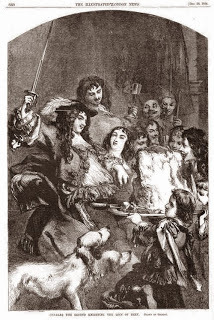 Charles II knighting the beef: Sir Loin An old tale that is difficult to verify tells of a monarch -- in various versions Henry VIII, Elizabeth I, James I, or Charles II -- who drew a sword and knighted a delicious cut of beef. "Arise, Sir Loin," the monarch supposedly said, and thus the finest cuts of beef are so named. True or not, it is an amusing story.
Charles II knighting the beef: Sir Loin An old tale that is difficult to verify tells of a monarch -- in various versions Henry VIII, Elizabeth I, James I, or Charles II -- who drew a sword and knighted a delicious cut of beef. "Arise, Sir Loin," the monarch supposedly said, and thus the finest cuts of beef are so named. True or not, it is an amusing story.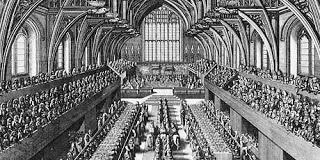 Coronation Banquet for James II
Coronation Banquet for James IIA story that is substantiated in many accounts is the coronation banquet of James II (1633-1701), held in Westminster Hall, April 23, 1685. It began at 11:30 am with the arrival of the King and Queen, but other participants had to be in place much earlier. Royalty departed at 7 pm, after the diners had been served 1,145 dishes, including many cuts of meat, sweetmeats, jellies and blancmange. James II did not last long as king; he was replaced in the Glorious Revolution of 1688 by William III of Orange and his Queen, James's daughter Mary.
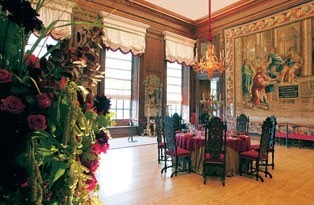 King's Eating Room, Hampton Court Palace William and Mary added on to Hampton Court Palace, and the King's Eating Room is now available for you to hire for your own soiree, if you so desire. As the website says, "It seems an odd idea to us now, but if you visited court in the 18th century one of the highlights would be watching the king eating his dinner. Anyone respectable enough and well-dressed enough (ie, wearing their coat, wig, sword….) would be admitted to see the sight, which took place several times a month. During public dining, King William III or King George II would not sit down to eat with their friends, but would be served in solitary splendour at a table in this room, with the crowds of spectators respectfully standing back. For more information, click here.
King's Eating Room, Hampton Court Palace William and Mary added on to Hampton Court Palace, and the King's Eating Room is now available for you to hire for your own soiree, if you so desire. As the website says, "It seems an odd idea to us now, but if you visited court in the 18th century one of the highlights would be watching the king eating his dinner. Anyone respectable enough and well-dressed enough (ie, wearing their coat, wig, sword….) would be admitted to see the sight, which took place several times a month. During public dining, King William III or King George II would not sit down to eat with their friends, but would be served in solitary splendour at a table in this room, with the crowds of spectators respectfully standing back. For more information, click here.
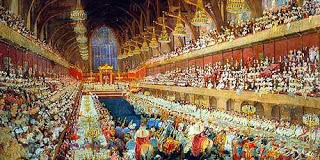 Coronation Banquet of George IV, 1821 Westminster Hall was also the scene of George IV's coronation banquet, the last one held there, although many of us certainly remember the Diamond Jubilee luncheon served there in 2012. As his reputation as a Voluptuary (see Gillray, below) might predict, George IV presided over an expensive and (melo)dramatic pageant for his coronation, which is probably best remembered for locking the door against his estranged wife, who was prepared to be crowned as queen. One of the accounts of the banquet enumerated some of the dishes served, "soups including turtle, salmon, turbot, and trout, venison and veal, mutton and beef, braised ham and savoury pies, daubed geese and braised capon, lobster and crayfish, cold roast fowl and cold lamb, potatoes, peas and cauliflower. There were mounted pastries, dishes of jellies and creams, over a thousand side dishes, nearly five hundred sauce boats brimming with lobster sauce, butter sauce and mint."
Coronation Banquet of George IV, 1821 Westminster Hall was also the scene of George IV's coronation banquet, the last one held there, although many of us certainly remember the Diamond Jubilee luncheon served there in 2012. As his reputation as a Voluptuary (see Gillray, below) might predict, George IV presided over an expensive and (melo)dramatic pageant for his coronation, which is probably best remembered for locking the door against his estranged wife, who was prepared to be crowned as queen. One of the accounts of the banquet enumerated some of the dishes served, "soups including turtle, salmon, turbot, and trout, venison and veal, mutton and beef, braised ham and savoury pies, daubed geese and braised capon, lobster and crayfish, cold roast fowl and cold lamb, potatoes, peas and cauliflower. There were mounted pastries, dishes of jellies and creams, over a thousand side dishes, nearly five hundred sauce boats brimming with lobster sauce, butter sauce and mint.".
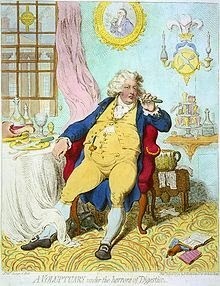 A Voluptuary under the horrors of Digestion, James Gillray, 1792British Museum This post is just nibble (pun intended) of the delights in Suzanne Groom's new book, At the King's Table. I will add that the sponsors of her talk had the good taste to serve cheese and crackers and a small glass of wine rather than compete with royalty!
A Voluptuary under the horrors of Digestion, James Gillray, 1792British Museum This post is just nibble (pun intended) of the delights in Suzanne Groom's new book, At the King's Table. I will add that the sponsors of her talk had the good taste to serve cheese and crackers and a small glass of wine rather than compete with royalty!Soon, an account of an exhibition at the Newberry Library concerning the American Civil War -- including the role of Great Britain
Published on October 30, 2013 00:30
October 28, 2013
Victoria Explores Euston/St. Pancras
On a warm morning last July, Ed and I returned to London from our marvelous foray into East Anglia. Ed was still worried about his sore foot and not too enthused about running around in London for the rest of our trip. So we decided to stay close to "home" for the afternoon. On our way out of the King's Cross RR Station we saw this cute display of Platform 9 3/4 where the students at Hogwarts School of Witchcraft and Wizardry leave London in the Harry Potter books.
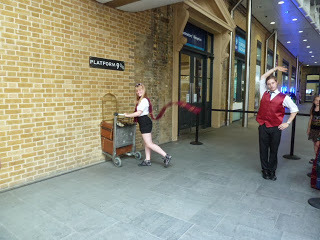 Outside, the Northern Hotel, next to Kings Cross has been attractively renovated.
Outside, the Northern Hotel, next to Kings Cross has been attractively renovated.
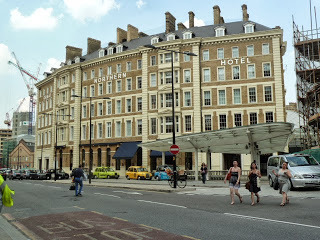
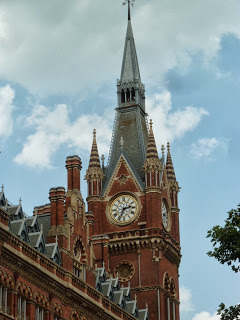 St. Pancras Station And next door to King's Cross and the Northern Hotel is St. Pancras, now the terminal for the Eurostar trains to Paris and Brussels. As such, it has caused a dramatic gentrification in the neighborhood. Almost all the buildings nearby along Euston Road were wrapped in scaffolding and cranes pierced the skies everywhere. We saw many signs for the offices of international conglomerates.
St. Pancras Station And next door to King's Cross and the Northern Hotel is St. Pancras, now the terminal for the Eurostar trains to Paris and Brussels. As such, it has caused a dramatic gentrification in the neighborhood. Almost all the buildings nearby along Euston Road were wrapped in scaffolding and cranes pierced the skies everywhere. We saw many signs for the offices of international conglomerates.
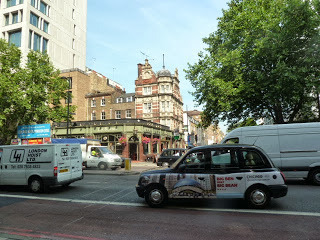 through the traffic to Chalton Street We found several pubs and bistros on Chalton Street beside our hotel, and I wondered how long this thoroughfare of little shops and newsstands could withstand the pressure of rising prices and new construction all around. Seems sad they might have to move and be replaced by the same chains one sees in Piccadilly. That's the down side of gentrification.
through the traffic to Chalton Street We found several pubs and bistros on Chalton Street beside our hotel, and I wondered how long this thoroughfare of little shops and newsstands could withstand the pressure of rising prices and new construction all around. Seems sad they might have to move and be replaced by the same chains one sees in Piccadilly. That's the down side of gentrification.
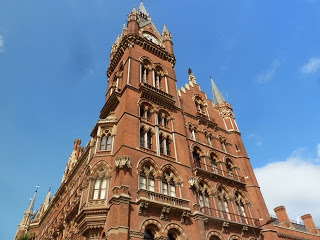 St. Pancras Hotel The upside of gentrification is the renovation of great old buildings like the Northern Hotel and the St. Pancras Hotel. a fantasy of Victorian wretched excess that is quite charming for all its Neo-Gothic extremes. Here are a few shots of the exterior décor.
St. Pancras Hotel The upside of gentrification is the renovation of great old buildings like the Northern Hotel and the St. Pancras Hotel. a fantasy of Victorian wretched excess that is quite charming for all its Neo-Gothic extremes. Here are a few shots of the exterior décor.
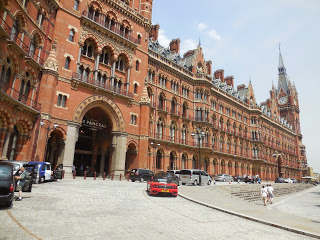
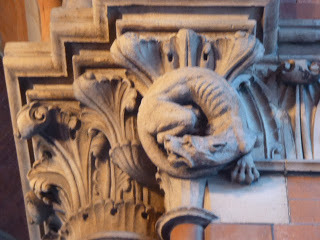
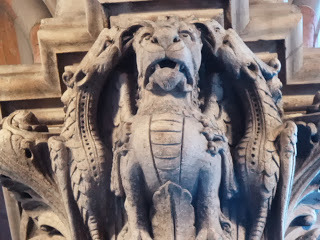
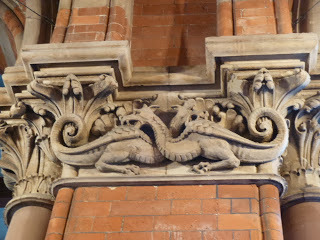 I assume the Hotel, a very posh place, has antidotes to nightmares caused by these gargoyles. The architect of the hotel, opened originally in 1868 as the Midland Grand Hotel, was Sir George Gilbert Scott (1811-1878), who is also responsible for the Albert Memorial in Hyde Park and the Foreign and Commonwealth Office in Whitehall at King Charles Street. Sir George would be proud of the restoration I am sure. Although we could hardly afford to stay there, we did enjoy a wonderful luncheon in the restaurant called "The Booking Office."
I assume the Hotel, a very posh place, has antidotes to nightmares caused by these gargoyles. The architect of the hotel, opened originally in 1868 as the Midland Grand Hotel, was Sir George Gilbert Scott (1811-1878), who is also responsible for the Albert Memorial in Hyde Park and the Foreign and Commonwealth Office in Whitehall at King Charles Street. Sir George would be proud of the restoration I am sure. Although we could hardly afford to stay there, we did enjoy a wonderful luncheon in the restaurant called "The Booking Office."
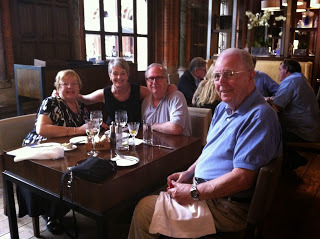 Vicky, Rev. Susan, Dr. Jim, and Ed
Vicky, Rev. Susan, Dr. Jim, and Ed
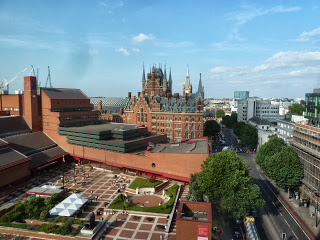 View from Pullman St. Pancras Hotel of the British Library (foreground) and the St. Pancras Hotel and Station in Euston Road
View from Pullman St. Pancras Hotel of the British Library (foreground) and the St. Pancras Hotel and Station in Euston Road
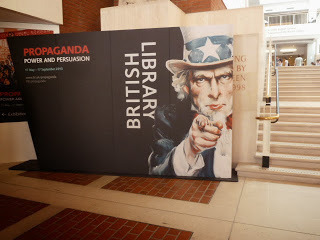 Exhibit in the British Library In the courtyard of the BL, an people were enjoying the warm afternoon, sipping cool drinks, reading, talking and/or checking their mobiles. We visited the Propaganda exhibit, then walked around the permanent exhibit where there are copies of the Magna Carta, ancient maps, the Beatles' songs, Jane Austen's desk, and other fascinating manuscripts and objects.
Exhibit in the British Library In the courtyard of the BL, an people were enjoying the warm afternoon, sipping cool drinks, reading, talking and/or checking their mobiles. We visited the Propaganda exhibit, then walked around the permanent exhibit where there are copies of the Magna Carta, ancient maps, the Beatles' songs, Jane Austen's desk, and other fascinating manuscripts and objects.
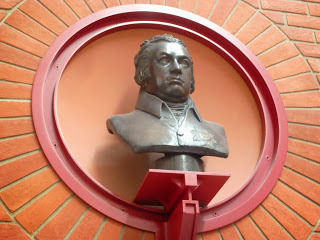 Sir Joseph Banks (1743-1820)by sculptor Anne Seymour DamerAmong the busts of the Library Founders.
Sir Joseph Banks (1743-1820)by sculptor Anne Seymour DamerAmong the busts of the Library Founders.
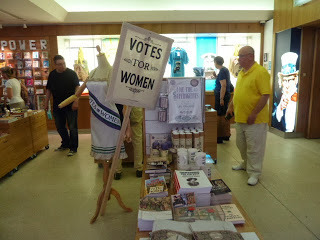 In the gift/book shop
In the gift/book shop
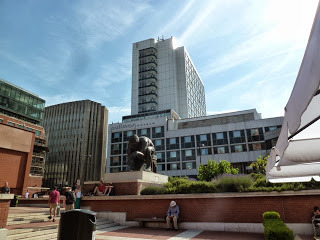 Looking at our tall hotel from the BL Courtyard
Looking at our tall hotel from the BL Courtyard
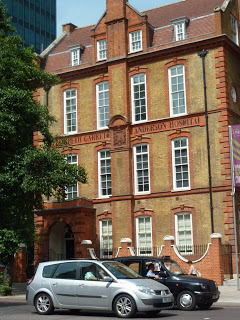 The Elizabeth Garret Anderson Hospital A little farther west on Euston Road, near Euston Station, is the building above, which was built by Britain's first woman physician and surgeon. It has become part of the new National Headquarters for the public service trade union Unison. Elizabeth Garret Anderson's life story is fascinating. Check it out here.
The Elizabeth Garret Anderson Hospital A little farther west on Euston Road, near Euston Station, is the building above, which was built by Britain's first woman physician and surgeon. It has become part of the new National Headquarters for the public service trade union Unison. Elizabeth Garret Anderson's life story is fascinating. Check it out here.
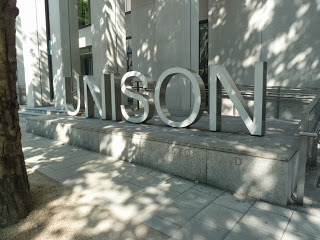 Two more neighborhood institutions were well worth our visit. The St. Pancras Church at the corner of Euston Road and Upper Woburn Place was constructed in 1819-1822 and designed by architect William Inwood and his son, Henry Inwood.
Two more neighborhood institutions were well worth our visit. The St. Pancras Church at the corner of Euston Road and Upper Woburn Place was constructed in 1819-1822 and designed by architect William Inwood and his son, Henry Inwood.
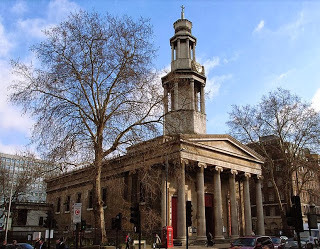 The building was modeled on two Athens landmarks from the Acropolis: the Tower of the Winds and the Erechtheum, the latter with its Ionic columns and the Porch of the Caryatids.
The building was modeled on two Athens landmarks from the Acropolis: the Tower of the Winds and the Erechtheum, the latter with its Ionic columns and the Porch of the Caryatids.
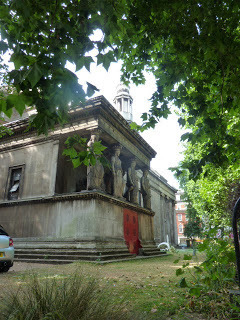 Porch of the Caryatids
Porch of the Caryatids
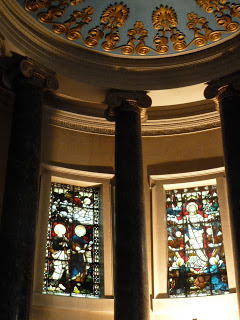 The Apse, St. Pancras Church The final neighborhood attraction we visited was the fascinating premises of the Wellcome Collection. The objects displayed were acquired by Sir Henry Wellcome (1845-1936), who explored the relationship of art, medicine, and the human body.
The Apse, St. Pancras Church The final neighborhood attraction we visited was the fascinating premises of the Wellcome Collection. The objects displayed were acquired by Sir Henry Wellcome (1845-1936), who explored the relationship of art, medicine, and the human body.
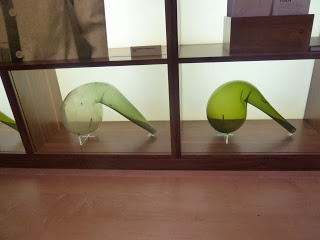 beakers, two of 100's
beakers, two of 100's
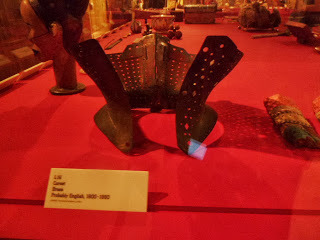 Iron Corset
Iron Corset
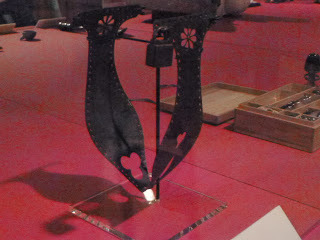 A Chastity Belt of iron and velvet The Wellcome Collection advertises itself as "the free destination for the incurably curious." Ed ad I found this a perfect description of the odd assortment of items in the museum. Also part of the Wellcome Trust are educational organizations and a medical library. If you are looking for the unusual in London, you will find it here. We enjoyed this Euston Road neighborhood, with its diverse institutions and attractions.
A Chastity Belt of iron and velvet The Wellcome Collection advertises itself as "the free destination for the incurably curious." Ed ad I found this a perfect description of the odd assortment of items in the museum. Also part of the Wellcome Trust are educational organizations and a medical library. If you are looking for the unusual in London, you will find it here. We enjoyed this Euston Road neighborhood, with its diverse institutions and attractions.
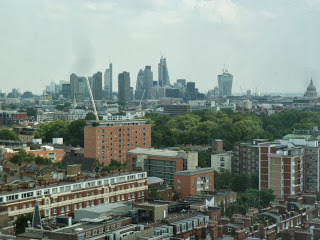 View of the City from the Pullman Hotel, St. Paul's Cathedral at the far right in the distance My visit to the Wellington Arch is coming soon.
View of the City from the Pullman Hotel, St. Paul's Cathedral at the far right in the distance My visit to the Wellington Arch is coming soon.
 Outside, the Northern Hotel, next to Kings Cross has been attractively renovated.
Outside, the Northern Hotel, next to Kings Cross has been attractively renovated.

 St. Pancras Station And next door to King's Cross and the Northern Hotel is St. Pancras, now the terminal for the Eurostar trains to Paris and Brussels. As such, it has caused a dramatic gentrification in the neighborhood. Almost all the buildings nearby along Euston Road were wrapped in scaffolding and cranes pierced the skies everywhere. We saw many signs for the offices of international conglomerates.
St. Pancras Station And next door to King's Cross and the Northern Hotel is St. Pancras, now the terminal for the Eurostar trains to Paris and Brussels. As such, it has caused a dramatic gentrification in the neighborhood. Almost all the buildings nearby along Euston Road were wrapped in scaffolding and cranes pierced the skies everywhere. We saw many signs for the offices of international conglomerates.
 through the traffic to Chalton Street We found several pubs and bistros on Chalton Street beside our hotel, and I wondered how long this thoroughfare of little shops and newsstands could withstand the pressure of rising prices and new construction all around. Seems sad they might have to move and be replaced by the same chains one sees in Piccadilly. That's the down side of gentrification.
through the traffic to Chalton Street We found several pubs and bistros on Chalton Street beside our hotel, and I wondered how long this thoroughfare of little shops and newsstands could withstand the pressure of rising prices and new construction all around. Seems sad they might have to move and be replaced by the same chains one sees in Piccadilly. That's the down side of gentrification.
 St. Pancras Hotel The upside of gentrification is the renovation of great old buildings like the Northern Hotel and the St. Pancras Hotel. a fantasy of Victorian wretched excess that is quite charming for all its Neo-Gothic extremes. Here are a few shots of the exterior décor.
St. Pancras Hotel The upside of gentrification is the renovation of great old buildings like the Northern Hotel and the St. Pancras Hotel. a fantasy of Victorian wretched excess that is quite charming for all its Neo-Gothic extremes. Here are a few shots of the exterior décor.



 I assume the Hotel, a very posh place, has antidotes to nightmares caused by these gargoyles. The architect of the hotel, opened originally in 1868 as the Midland Grand Hotel, was Sir George Gilbert Scott (1811-1878), who is also responsible for the Albert Memorial in Hyde Park and the Foreign and Commonwealth Office in Whitehall at King Charles Street. Sir George would be proud of the restoration I am sure. Although we could hardly afford to stay there, we did enjoy a wonderful luncheon in the restaurant called "The Booking Office."
I assume the Hotel, a very posh place, has antidotes to nightmares caused by these gargoyles. The architect of the hotel, opened originally in 1868 as the Midland Grand Hotel, was Sir George Gilbert Scott (1811-1878), who is also responsible for the Albert Memorial in Hyde Park and the Foreign and Commonwealth Office in Whitehall at King Charles Street. Sir George would be proud of the restoration I am sure. Although we could hardly afford to stay there, we did enjoy a wonderful luncheon in the restaurant called "The Booking Office."
 Vicky, Rev. Susan, Dr. Jim, and Ed
Vicky, Rev. Susan, Dr. Jim, and Ed
 View from Pullman St. Pancras Hotel of the British Library (foreground) and the St. Pancras Hotel and Station in Euston Road
View from Pullman St. Pancras Hotel of the British Library (foreground) and the St. Pancras Hotel and Station in Euston Road
 Exhibit in the British Library In the courtyard of the BL, an people were enjoying the warm afternoon, sipping cool drinks, reading, talking and/or checking their mobiles. We visited the Propaganda exhibit, then walked around the permanent exhibit where there are copies of the Magna Carta, ancient maps, the Beatles' songs, Jane Austen's desk, and other fascinating manuscripts and objects.
Exhibit in the British Library In the courtyard of the BL, an people were enjoying the warm afternoon, sipping cool drinks, reading, talking and/or checking their mobiles. We visited the Propaganda exhibit, then walked around the permanent exhibit where there are copies of the Magna Carta, ancient maps, the Beatles' songs, Jane Austen's desk, and other fascinating manuscripts and objects.
 Sir Joseph Banks (1743-1820)by sculptor Anne Seymour DamerAmong the busts of the Library Founders.
Sir Joseph Banks (1743-1820)by sculptor Anne Seymour DamerAmong the busts of the Library Founders.
 In the gift/book shop
In the gift/book shop
 Looking at our tall hotel from the BL Courtyard
Looking at our tall hotel from the BL Courtyard
 The Elizabeth Garret Anderson Hospital A little farther west on Euston Road, near Euston Station, is the building above, which was built by Britain's first woman physician and surgeon. It has become part of the new National Headquarters for the public service trade union Unison. Elizabeth Garret Anderson's life story is fascinating. Check it out here.
The Elizabeth Garret Anderson Hospital A little farther west on Euston Road, near Euston Station, is the building above, which was built by Britain's first woman physician and surgeon. It has become part of the new National Headquarters for the public service trade union Unison. Elizabeth Garret Anderson's life story is fascinating. Check it out here.
 Two more neighborhood institutions were well worth our visit. The St. Pancras Church at the corner of Euston Road and Upper Woburn Place was constructed in 1819-1822 and designed by architect William Inwood and his son, Henry Inwood.
Two more neighborhood institutions were well worth our visit. The St. Pancras Church at the corner of Euston Road and Upper Woburn Place was constructed in 1819-1822 and designed by architect William Inwood and his son, Henry Inwood.
 The building was modeled on two Athens landmarks from the Acropolis: the Tower of the Winds and the Erechtheum, the latter with its Ionic columns and the Porch of the Caryatids.
The building was modeled on two Athens landmarks from the Acropolis: the Tower of the Winds and the Erechtheum, the latter with its Ionic columns and the Porch of the Caryatids.
 Porch of the Caryatids
Porch of the Caryatids
 The Apse, St. Pancras Church The final neighborhood attraction we visited was the fascinating premises of the Wellcome Collection. The objects displayed were acquired by Sir Henry Wellcome (1845-1936), who explored the relationship of art, medicine, and the human body.
The Apse, St. Pancras Church The final neighborhood attraction we visited was the fascinating premises of the Wellcome Collection. The objects displayed were acquired by Sir Henry Wellcome (1845-1936), who explored the relationship of art, medicine, and the human body.
 beakers, two of 100's
beakers, two of 100's
 Iron Corset
Iron Corset
 A Chastity Belt of iron and velvet The Wellcome Collection advertises itself as "the free destination for the incurably curious." Ed ad I found this a perfect description of the odd assortment of items in the museum. Also part of the Wellcome Trust are educational organizations and a medical library. If you are looking for the unusual in London, you will find it here. We enjoyed this Euston Road neighborhood, with its diverse institutions and attractions.
A Chastity Belt of iron and velvet The Wellcome Collection advertises itself as "the free destination for the incurably curious." Ed ad I found this a perfect description of the odd assortment of items in the museum. Also part of the Wellcome Trust are educational organizations and a medical library. If you are looking for the unusual in London, you will find it here. We enjoyed this Euston Road neighborhood, with its diverse institutions and attractions.
 View of the City from the Pullman Hotel, St. Paul's Cathedral at the far right in the distance My visit to the Wellington Arch is coming soon.
View of the City from the Pullman Hotel, St. Paul's Cathedral at the far right in the distance My visit to the Wellington Arch is coming soon.
Published on October 28, 2013 00:30
October 25, 2013
Artist Thomas Sully in Milwaukee

Victoria here, reporting on a wonderful exhibition at my local hang-out, the Milwaukee Art Museum. Last year about this time I was observing the wonderful exhibition at the MAM from London's Kenwood House. Click here if you need a reminder.
This autumn we are fortunate to have a gathering of works from many museums for Thomas Sully: Painted Performance. After it closes in Milwaukee in January, the exhibition will travel to the San Antonio Museum of Art February 7 through May 11, 2014.
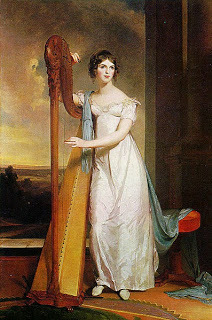 Lady with a Harp Eliza Ridgeway, 1818, National Gallery of Art, Washington, D.C. This is one of my favorite paintings in Washington and I usually breeze by to say hello on my annual forays to the capital. Now here she is in my front yard.
Lady with a Harp Eliza Ridgeway, 1818, National Gallery of Art, Washington, D.C. This is one of my favorite paintings in Washington and I usually breeze by to say hello on my annual forays to the capital. Now here she is in my front yard.
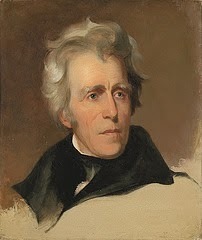 Andrew Jackson, 1845National Gallery of Art, Washington, D.C. The Andrew Jackson portrait is very familiar to all Americans as the inspiration of the etching on the $20 bill.
Andrew Jackson, 1845National Gallery of Art, Washington, D.C. The Andrew Jackson portrait is very familiar to all Americans as the inspiration of the etching on the $20 bill.
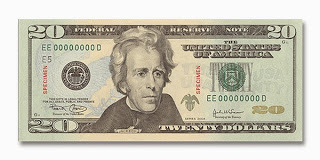 Thomas Sully (1783–1872) was born in Lincolnshire, England, to a family in the theatrical business. In 1792, they settled in Charleston, South Carolina. Though young Tom often acted, his skills in sketching and painting were soon evident. Eventually he worked with his brother Lawrence, also a painter. Tom moved around from Richmond, VA, to New York, and for a while to Boston to study with Gilbert Stuart, perhaps the young republic's most renowned artist. Sully settled in Philadelphia in 1806; there he stayed for the rest of his life, other than time in 1809 studying in London with Benjamin West and later a London trip to paint the young Queen Victoria in 1837-38.
Thomas Sully (1783–1872) was born in Lincolnshire, England, to a family in the theatrical business. In 1792, they settled in Charleston, South Carolina. Though young Tom often acted, his skills in sketching and painting were soon evident. Eventually he worked with his brother Lawrence, also a painter. Tom moved around from Richmond, VA, to New York, and for a while to Boston to study with Gilbert Stuart, perhaps the young republic's most renowned artist. Sully settled in Philadelphia in 1806; there he stayed for the rest of his life, other than time in 1809 studying in London with Benjamin West and later a London trip to paint the young Queen Victoria in 1837-38.
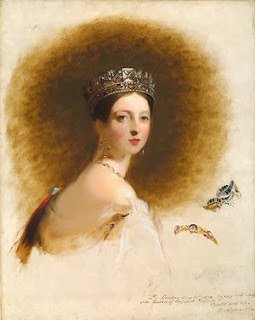 Queen Victoria, Metropolitan Museum of Art Other versions of this painting hang in the Wallace Collection in London and the Royal Collection as well. Below, a full length version, not in this exhibition.
Queen Victoria, Metropolitan Museum of Art Other versions of this painting hang in the Wallace Collection in London and the Royal Collection as well. Below, a full length version, not in this exhibition.
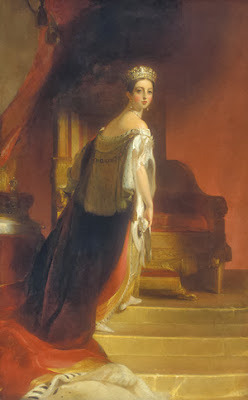 Queen Victoria, 1838Metropolitan Museum of Art, NYC Among the amazing 2300 pictures Sully painted are many American politicians and other citizens, both men and women. The focus of this MAM exhibition is performance, particularly on the stage.
Queen Victoria, 1838Metropolitan Museum of Art, NYC Among the amazing 2300 pictures Sully painted are many American politicians and other citizens, both men and women. The focus of this MAM exhibition is performance, particularly on the stage.
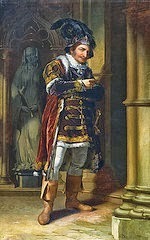 George Frederick Cooke, in the role of Shakespeare's Richard III Pennsylvania Academy of the Fine Arts
George Frederick Cooke, in the role of Shakespeare's Richard III Pennsylvania Academy of the Fine Arts
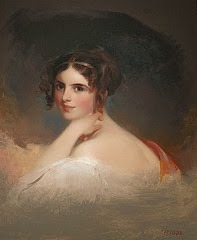 Famed Actress Frances Anne (Fanny) Kemble as Beatrice, 1833Pennsylvania Academy of the Fine Arts
Famed Actress Frances Anne (Fanny) Kemble as Beatrice, 1833Pennsylvania Academy of the Fine Arts
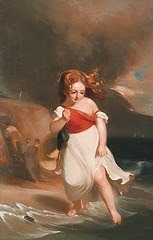 Sarah Esther Hindman as Little Red Riding Hood, 1833 The Maryland State Archives, Photo by Harry Connolly Sully not only painted actors; he also produced many paintings illustrating scenes from books and other "Fancy" pictures, many of which were reproduced for widespread purchase and display in everyday homes.
Sarah Esther Hindman as Little Red Riding Hood, 1833 The Maryland State Archives, Photo by Harry Connolly Sully not only painted actors; he also produced many paintings illustrating scenes from books and other "Fancy" pictures, many of which were reproduced for widespread purchase and display in everyday homes.
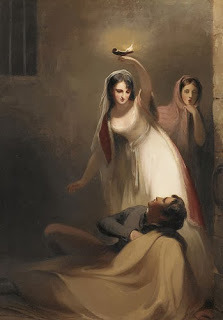 Prison Scene from James Fenimore Cooper's "The Pilot", 1841Birmingham (AL) Museum of Art
Prison Scene from James Fenimore Cooper's "The Pilot", 1841Birmingham (AL) Museum of Art
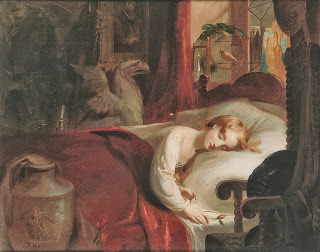 Little Nell Asleep in Dickens' The Old Curiosity ShopFree Library of Philadelphia
Little Nell Asleep in Dickens' The Old Curiosity ShopFree Library of Philadelphia
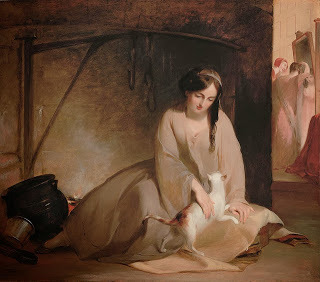 Cinderella at the Kitchen Fire, 1843Dallas Museum of Art Among Thomas Sully's most prized paintings are his many portraits, and particularly the adorable lad below, beloved to generations of MFA visitors.
Cinderella at the Kitchen Fire, 1843Dallas Museum of Art Among Thomas Sully's most prized paintings are his many portraits, and particularly the adorable lad below, beloved to generations of MFA visitors.
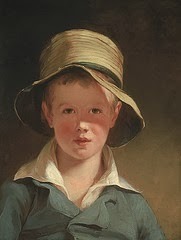 The Torn Hat, 1820© 2013, Museum of Fine Arts, Boston
The Torn Hat, 1820© 2013, Museum of Fine Arts, Boston
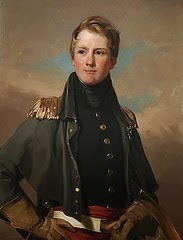 Major Thomas Biddle, 1818Pennsylvania Academy of the Fine Arts, Philadelphia I am looking forward to rambling around among these pictures many times in the next couple of months. Sully's work has a luminosity I love. When this blog visited the Look of Love exhibition in Birmingham, we became acquainted with Tom Sully, great , great, great grandson of Thomas Sully and himself a renowned artist. For our interview with Tom, click here. This is the first Thomas Sully retrospective in thirty years, showing about eighty paintings. Thomas Sully: Painted Performance is organized by the Milwaukee Art Museum, co-curated by Dr. William Keyse Rudolph, the Museum’s Dudley J. Godfrey Jr. Curator of American Art and Decorative Arts and Director of Exhibitions, and Dr. Carol Eaton Soltis, Project Associate Curator of American Art, Philadelphia Museum of Art.
Major Thomas Biddle, 1818Pennsylvania Academy of the Fine Arts, Philadelphia I am looking forward to rambling around among these pictures many times in the next couple of months. Sully's work has a luminosity I love. When this blog visited the Look of Love exhibition in Birmingham, we became acquainted with Tom Sully, great , great, great grandson of Thomas Sully and himself a renowned artist. For our interview with Tom, click here. This is the first Thomas Sully retrospective in thirty years, showing about eighty paintings. Thomas Sully: Painted Performance is organized by the Milwaukee Art Museum, co-curated by Dr. William Keyse Rudolph, the Museum’s Dudley J. Godfrey Jr. Curator of American Art and Decorative Arts and Director of Exhibitions, and Dr. Carol Eaton Soltis, Project Associate Curator of American Art, Philadelphia Museum of Art.
Published on October 25, 2013 00:30
October 23, 2013
The Jane Austen Society in Minneapolis
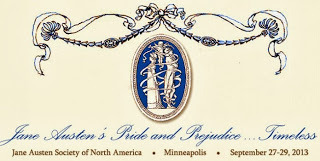
Seven hundred fans and scholars met in Minneapolis at the end of September for immersion in All Things Jane. Victoria here, relating my experience celebrating two hundred years of Pride and Prejudice with so many of those who love it too. Many thanks to Dave O'Brien for the use of his excellent photos, more of which can be seen on the JASNA-WI website.
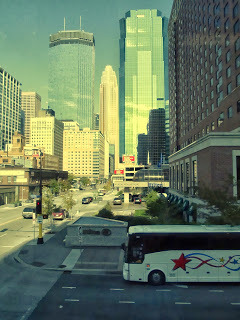 Minneapolis, 2013 As always at an AGM, part of the fun is touring the city and surroundings...and we had perfect weather to enjoy such treats as the Guthrie Theatre, the Mill Museum, tours devoted to F. Scott Fitzgerald and Sherlock Holmes, plus the art museums and pub crawls.
Minneapolis, 2013 As always at an AGM, part of the fun is touring the city and surroundings...and we had perfect weather to enjoy such treats as the Guthrie Theatre, the Mill Museum, tours devoted to F. Scott Fitzgerald and Sherlock Holmes, plus the art museums and pub crawls.
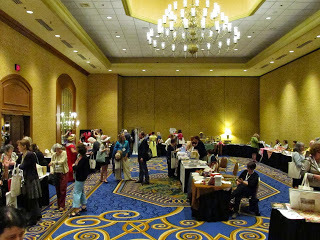 The Emporium Another popular feature of an AGM the Emporium where JASNA chapters and commercial providers have their sales tables. Books, hats, fans, pens and paper, English antique tea cups, all sorts of temptations abound.
The Emporium Another popular feature of an AGM the Emporium where JASNA chapters and commercial providers have their sales tables. Books, hats, fans, pens and paper, English antique tea cups, all sorts of temptations abound.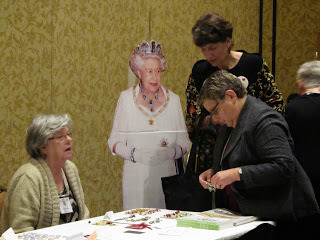 Kathy O'Brien entertains the Queen, Liz Cooper and a customer forJASNA-WI's 2014 Calendar. To order yours, click here.
Kathy O'Brien entertains the Queen, Liz Cooper and a customer forJASNA-WI's 2014 Calendar. To order yours, click here. 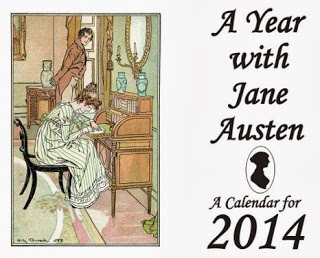
Below, editor Tim Bullamore collects subscribers to Jane Austen's Regency World magazine.
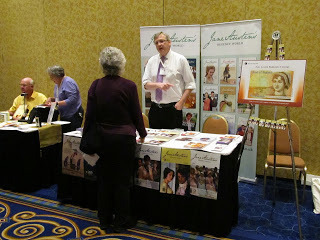 For more information on JARW, click here.
For more information on JARW, click here.
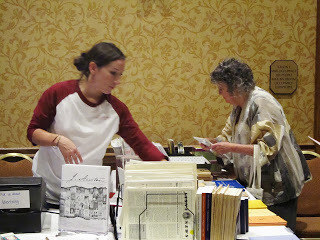 Jane Austen Books is always a popular vendor.
Jane Austen Books is always a popular vendor.
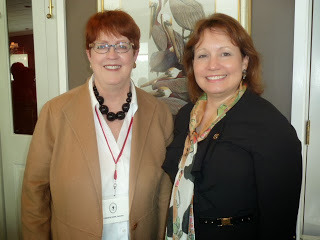 The Regency Room featured the antique collection of author Candice Hern, left with JASNA President Iris Lutz (in May 2013 in Madison, WI)
The Regency Room featured the antique collection of author Candice Hern, left with JASNA President Iris Lutz (in May 2013 in Madison, WI)
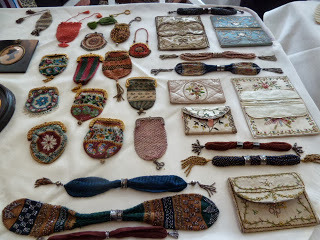 For more on Candice's Collections, click here.
For more on Candice's Collections, click here.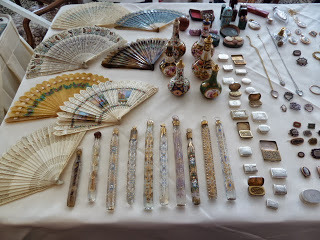 As in the past few years, the JASNA AGM events have become so numerous that many are held on the day before the official Keynote. In additions to tours and workshops, Thursday's speakers included Candice Hern on Regency Magazines; Bruce Richardson on the History of Tea and Jane Austen; a High Tea and Fashion Show; and Curtain Raiser Jocelyn Harris speaking on "Introducing Elizabeth Bennet."
As in the past few years, the JASNA AGM events have become so numerous that many are held on the day before the official Keynote. In additions to tours and workshops, Thursday's speakers included Candice Hern on Regency Magazines; Bruce Richardson on the History of Tea and Jane Austen; a High Tea and Fashion Show; and Curtain Raiser Jocelyn Harris speaking on "Introducing Elizabeth Bennet."
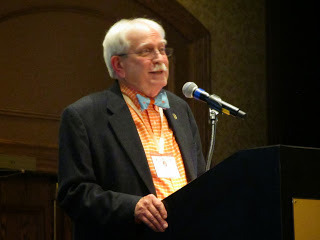 William Phillips of Chicago, a JASNA favorite speaker, spoke on card games: "Pride, Prejudice and Piquet" Friday morning was also crowded with tours, workshops dance lessons and excellent presentations.
William Phillips of Chicago, a JASNA favorite speaker, spoke on card games: "Pride, Prejudice and Piquet" Friday morning was also crowded with tours, workshops dance lessons and excellent presentations.
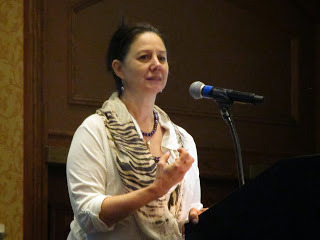 Sandy Lerner spoke on "Pen and Parsimony: Carriages in the Novels of Jane Austen"
Sandy Lerner spoke on "Pen and Parsimony: Carriages in the Novels of Jane Austen"
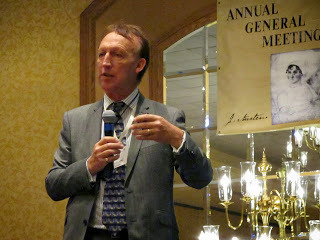 Steve Lawrence, CEO of Chawton House Library, updated us on events there.
Steve Lawrence, CEO of Chawton House Library, updated us on events there.
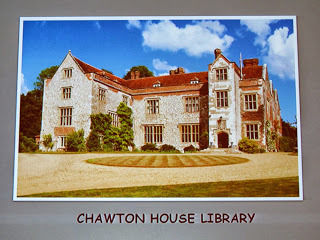 I attended the Frances Burney Society AGM, Luncheon, and excellent talk by Dr. Lorna Clark who spoke about Burney's private writings in the context of her work editing a new edition of two volumes of The Court Journals and Letters of Frances Burney.
I attended the Frances Burney Society AGM, Luncheon, and excellent talk by Dr. Lorna Clark who spoke about Burney's private writings in the context of her work editing a new edition of two volumes of The Court Journals and Letters of Frances Burney.
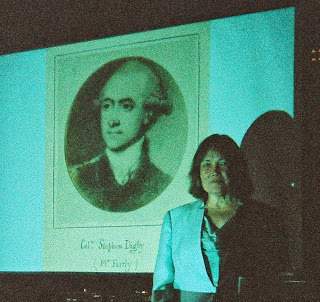 Dr. Lorna Clark
Dr. Lorna Clark 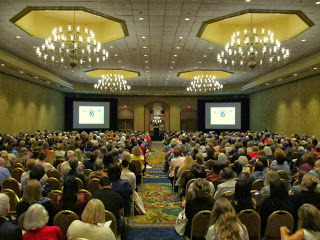 The Opening Plenary Session of the 2013 JASNA AGM,The Carol Medine Moss Keynote Lecture,a very entertaining and insightful session.
The Opening Plenary Session of the 2013 JASNA AGM,The Carol Medine Moss Keynote Lecture,a very entertaining and insightful session.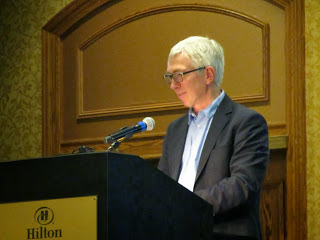 Professor James Mullan of University College LondonSpeechless in Pride and Prejudiceauthor of What Matters in Jane Austen: 20 Crucial Puzzles Solved
Professor James Mullan of University College LondonSpeechless in Pride and Prejudiceauthor of What Matters in Jane Austen: 20 Crucial Puzzles Solved
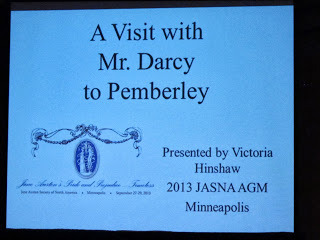 My turn for a Break-out Session
My turn for a Break-out Session
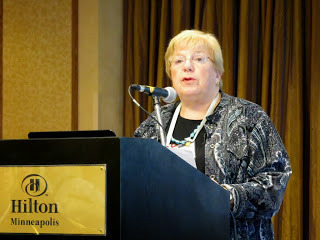 She is SERIOUS!ABC Nightline filmed my entire presentation, but I fear I ended up on the cutting room floor.
She is SERIOUS!ABC Nightline filmed my entire presentation, but I fear I ended up on the cutting room floor.
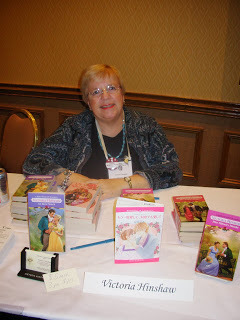 Here I am at the book signing on Friday evening. In the middle is the Japanese Manga version ofMiss Milford's Mistake. I'd brought it as an object of curiosity, but a lady bought it to send to a library in Japan. What fun! Thanks to Julie Klassen for the picture! Here are some other views of Break-out speakers.
Here I am at the book signing on Friday evening. In the middle is the Japanese Manga version ofMiss Milford's Mistake. I'd brought it as an object of curiosity, but a lady bought it to send to a library in Japan. What fun! Thanks to Julie Klassen for the picture! Here are some other views of Break-out speakers. 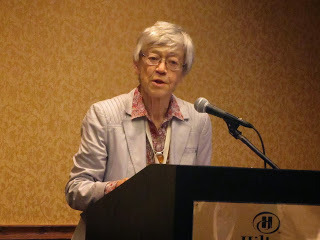 Juliet McMaster
Juliet McMaster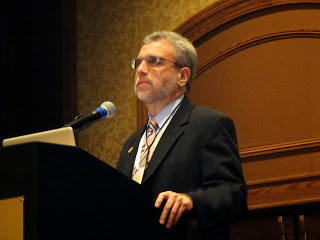 Jeffrey Nigro
Jeffrey Nigro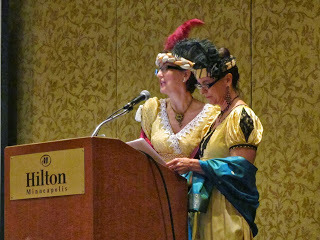 The Bingley Sisters: Liz Philosophos Cooper and Molly Philosophos
The Bingley Sisters: Liz Philosophos Cooper and Molly Philosophos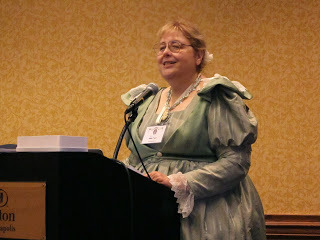 Susan Forgue
Susan Forgue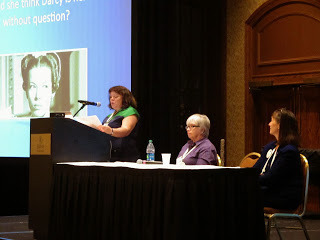 Teresa Kinney, Joan Ray, and Cheryl Kinney
Teresa Kinney, Joan Ray, and Cheryl Kinney
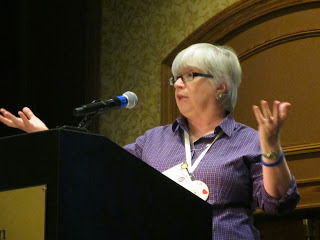 Plenary speaker Joan K. Ray on "Do Elizabeth and Darcy Really Improve Upon Acquaintance?"Dr. Ray challenged us with a new approach to Darcy's tolerance and Elizabeth's grudge. Plenary speaker Janine Barchas discussed "Naming Names in Pride and Prejudice" particularly the Fitzwilliam family of Wentworth Woodhouse and other "celebrity teasers" hidden in plain sight. These and other interesting sidelights on Jane Austen's characters can be found in Barchas's book, Matters of Fact in Jane Austen.
Plenary speaker Joan K. Ray on "Do Elizabeth and Darcy Really Improve Upon Acquaintance?"Dr. Ray challenged us with a new approach to Darcy's tolerance and Elizabeth's grudge. Plenary speaker Janine Barchas discussed "Naming Names in Pride and Prejudice" particularly the Fitzwilliam family of Wentworth Woodhouse and other "celebrity teasers" hidden in plain sight. These and other interesting sidelights on Jane Austen's characters can be found in Barchas's book, Matters of Fact in Jane Austen.
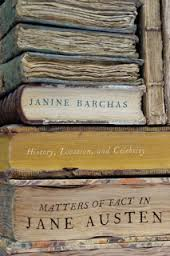
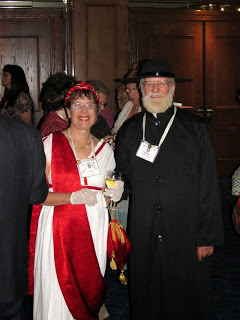 Nili Olay and Jerry Vetowich, after the Saturday Banquet
Nili Olay and Jerry Vetowich, after the Saturday Banquet
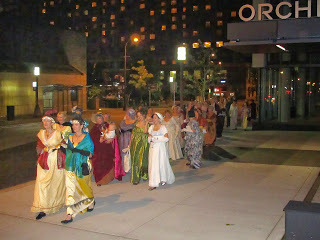 The Bingley Sisters lead the costumed promenade through the neighborhood
The Bingley Sisters lead the costumed promenade through the neighborhood
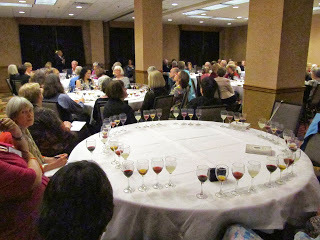 Bill Pierson instructs us on tasting "Libations In the Regency Manner"
Bill Pierson instructs us on tasting "Libations In the Regency Manner"
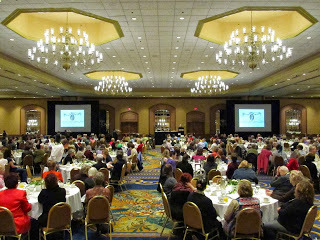 Sunday's Closing Brunch
Sunday's Closing Brunch
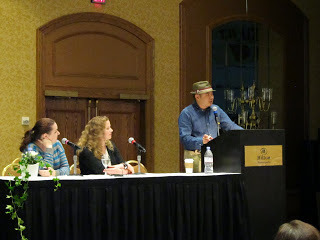 The Lizzie Bennet Diaries team on how they adapted Jane Austen's Pride and Prejudice for You-Tube episodes and won an Emmy!
The Lizzie Bennet Diaries team on how they adapted Jane Austen's Pride and Prejudice for You-Tube episodes and won an Emmy! 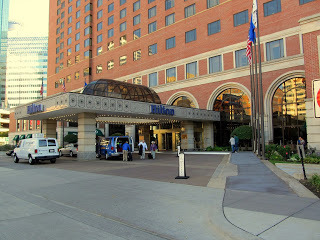 After packing in so many activities in just a few days, we say farewell to the Minneapolis AGM and look forward to Montreal in 2014Thanks again to Dave O'Brien for most of the photos. See more athttp://jasnawi.org/
After packing in so many activities in just a few days, we say farewell to the Minneapolis AGM and look forward to Montreal in 2014Thanks again to Dave O'Brien for most of the photos. See more athttp://jasnawi.org/
Published on October 23, 2013 00:30
October 21, 2013
Victoria at Holkham Hall, Part Two
My first post on Holkham Hall told you about my visit to the great mansion, but a trip to Norfolk to see the Coke estates involves more than the Hall. There is a wonderful hotel on the grounds, with the very appealing name of The Victoria Inn. Click here. Of course, I could not resist.
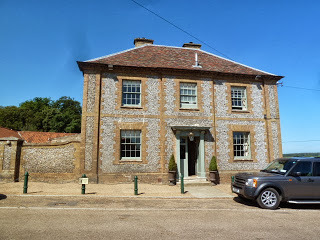 Entrance to the Victoria Inn
Entrance to the Victoria Inn
On the evening after my visit to nearby Houghton Hall with the still limping hubby Ed, we met our trusty taxi driver who took us to the Victoria Inn for our long-reserved two-night stay. The Inn is part of the Holkham Estate, officially in Wells-by-the-Sea.
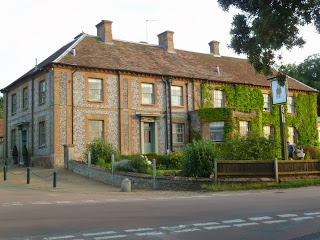 Victoria Inn from the road
Victoria Inn from the road
When we went into the dining room, we found that most of the other residents had spent hours on the beach, sandy sun-burned, and in the case of the children, all tired from an exciting treat of a day. You will remember, July was an unusually warm month in England.
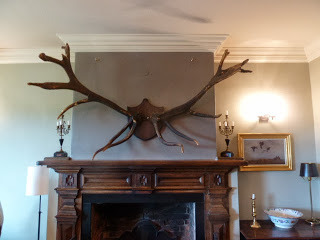 Ancient Antlers at The Victoria Lounge
Ancient Antlers at The Victoria Lounge
The cuisine was excellent, local specialties for the most part. After dinner, despite his aching foot, we took a few turns around the quaint village, and investigated the local wine store which also carried a Norfolk-distilled English Whiskey.
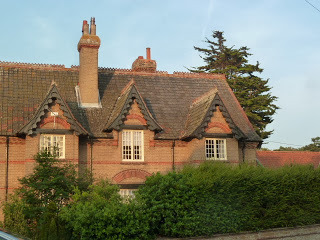 Holkham Village
Holkham Village
The next morning, deferring to Ed's painful foot, we decided against a walk on the beach, and accepted the kind offer of a young Inn employee to drive us up to the house. The Victoria is at the beginning of the driveway, but it is almost a mile to reach the mansion. We were most appreciative, especially when he agreed to return for us later in the afternoon. Norfolk people are the BEST!!!
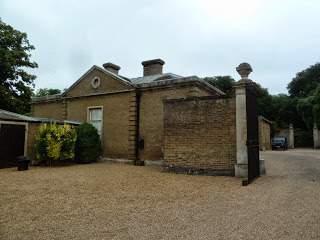
The House did not open for an hour or two, so we toured the Bygones Museum, in the outbuildings and stables near the Hall.
The Museum is an eclectic collection of objects from long ago and the recent past. Ed, former TV journalist and anchorman, enjoyed this bulky old TV camera. How well we remember it, now replaced with smaller digital HD descendants.
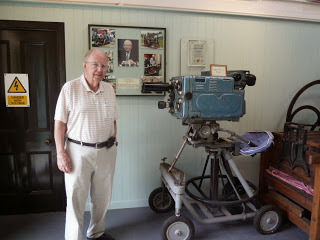
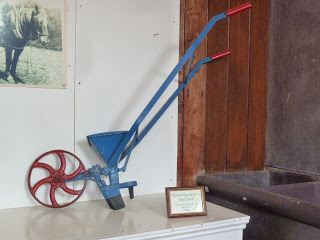 Seed Drill Many of the displays related to Coke of Norfolk's agricultural achievements. He was a great advocate of improvements in land, draining, fertilizing, and renewing the soil. Crop rotation was advocated, with a four year repeating cycle of planting root crops such as turnips, barley or oats the next year, then clover and grass for grazing and natural fertilization, and wheat in the fourth year, after which the cycle begins again.
Seed Drill Many of the displays related to Coke of Norfolk's agricultural achievements. He was a great advocate of improvements in land, draining, fertilizing, and renewing the soil. Crop rotation was advocated, with a four year repeating cycle of planting root crops such as turnips, barley or oats the next year, then clover and grass for grazing and natural fertilization, and wheat in the fourth year, after which the cycle begins again.
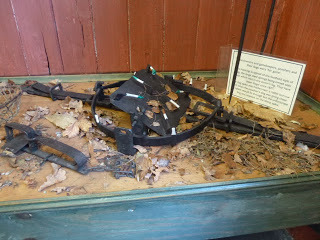 Mantrap
Mantrap
The less accommodating side of estate life is represented by the devices used to prevent or catch poachers. The deer in the park, the birds in the bush, and the fish in the streams were carefully cultivated and reserved for the use of the estate owners.
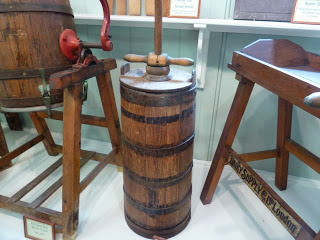 Dairy implements The dairy was an important supplier of milk, cream, butter and cheese from the estate herds.
Dairy implements The dairy was an important supplier of milk, cream, butter and cheese from the estate herds.
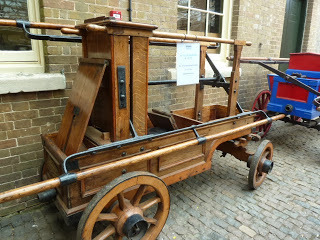 hand-pumped fire engine To protect the hundreds of people (and animals) who lived and worked on the estate, many dealing with open fires, it was necessary to have fire-fighting equipment ready to use.
hand-pumped fire engine To protect the hundreds of people (and animals) who lived and worked on the estate, many dealing with open fires, it was necessary to have fire-fighting equipment ready to use.
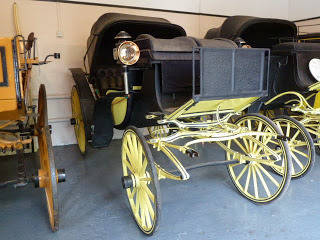
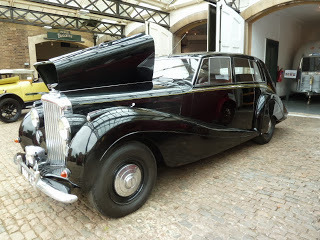 From horse-drawn carriages to a Rolls Royce, the museum was filled with vehicles of all sorts. After a little snack at the lovely tea ship on the premises, we decided to ride (on a small electric bus) to the walled garden, where restoration of the glass-houses and the flower beds is underway
From horse-drawn carriages to a Rolls Royce, the museum was filled with vehicles of all sorts. After a little snack at the lovely tea ship on the premises, we decided to ride (on a small electric bus) to the walled garden, where restoration of the glass-houses and the flower beds is underway
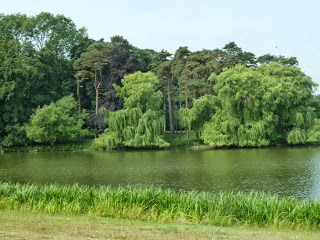 The lake
The lake 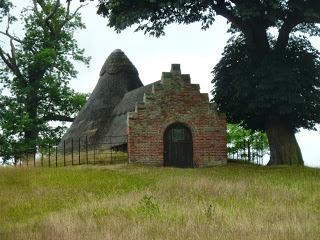 The ice house On the way, we passed acres of lawn, a large lake, and many outbuildings. The renewal of the 6.5- acre walled garden is a relatively new project, expected to be finished in the next year or two.
The ice house On the way, we passed acres of lawn, a large lake, and many outbuildings. The renewal of the 6.5- acre walled garden is a relatively new project, expected to be finished in the next year or two.
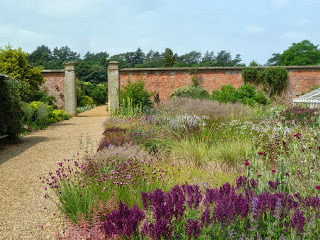
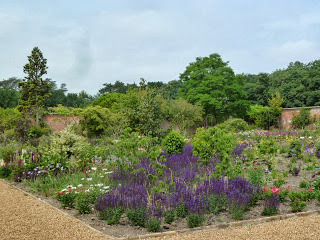
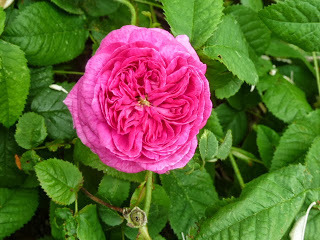 I simply cannot resist photographing the roses.
I simply cannot resist photographing the roses.
 Ed spent most of his time in the garden sitting on a convenient bench. I must say he was not up for the game of cricket on the lawn either. Not that we know the rules, but it certainly looked like the proper thing to do on a Sunday afternoon in Norfolk. The following day we returned to London and I will relate those adventures soon. Would it tempt you if I hinted that I was about to visit the British Library?
Ed spent most of his time in the garden sitting on a convenient bench. I must say he was not up for the game of cricket on the lawn either. Not that we know the rules, but it certainly looked like the proper thing to do on a Sunday afternoon in Norfolk. The following day we returned to London and I will relate those adventures soon. Would it tempt you if I hinted that I was about to visit the British Library?
 Entrance to the Victoria Inn
Entrance to the Victoria InnOn the evening after my visit to nearby Houghton Hall with the still limping hubby Ed, we met our trusty taxi driver who took us to the Victoria Inn for our long-reserved two-night stay. The Inn is part of the Holkham Estate, officially in Wells-by-the-Sea.
 Victoria Inn from the road
Victoria Inn from the roadWhen we went into the dining room, we found that most of the other residents had spent hours on the beach, sandy sun-burned, and in the case of the children, all tired from an exciting treat of a day. You will remember, July was an unusually warm month in England.
 Ancient Antlers at The Victoria Lounge
Ancient Antlers at The Victoria LoungeThe cuisine was excellent, local specialties for the most part. After dinner, despite his aching foot, we took a few turns around the quaint village, and investigated the local wine store which also carried a Norfolk-distilled English Whiskey.
 Holkham Village
Holkham VillageThe next morning, deferring to Ed's painful foot, we decided against a walk on the beach, and accepted the kind offer of a young Inn employee to drive us up to the house. The Victoria is at the beginning of the driveway, but it is almost a mile to reach the mansion. We were most appreciative, especially when he agreed to return for us later in the afternoon. Norfolk people are the BEST!!!

The House did not open for an hour or two, so we toured the Bygones Museum, in the outbuildings and stables near the Hall.
The Museum is an eclectic collection of objects from long ago and the recent past. Ed, former TV journalist and anchorman, enjoyed this bulky old TV camera. How well we remember it, now replaced with smaller digital HD descendants.

 Seed Drill Many of the displays related to Coke of Norfolk's agricultural achievements. He was a great advocate of improvements in land, draining, fertilizing, and renewing the soil. Crop rotation was advocated, with a four year repeating cycle of planting root crops such as turnips, barley or oats the next year, then clover and grass for grazing and natural fertilization, and wheat in the fourth year, after which the cycle begins again.
Seed Drill Many of the displays related to Coke of Norfolk's agricultural achievements. He was a great advocate of improvements in land, draining, fertilizing, and renewing the soil. Crop rotation was advocated, with a four year repeating cycle of planting root crops such as turnips, barley or oats the next year, then clover and grass for grazing and natural fertilization, and wheat in the fourth year, after which the cycle begins again. Mantrap
MantrapThe less accommodating side of estate life is represented by the devices used to prevent or catch poachers. The deer in the park, the birds in the bush, and the fish in the streams were carefully cultivated and reserved for the use of the estate owners.
 Dairy implements The dairy was an important supplier of milk, cream, butter and cheese from the estate herds.
Dairy implements The dairy was an important supplier of milk, cream, butter and cheese from the estate herds.
 hand-pumped fire engine To protect the hundreds of people (and animals) who lived and worked on the estate, many dealing with open fires, it was necessary to have fire-fighting equipment ready to use.
hand-pumped fire engine To protect the hundreds of people (and animals) who lived and worked on the estate, many dealing with open fires, it was necessary to have fire-fighting equipment ready to use.

 From horse-drawn carriages to a Rolls Royce, the museum was filled with vehicles of all sorts. After a little snack at the lovely tea ship on the premises, we decided to ride (on a small electric bus) to the walled garden, where restoration of the glass-houses and the flower beds is underway
From horse-drawn carriages to a Rolls Royce, the museum was filled with vehicles of all sorts. After a little snack at the lovely tea ship on the premises, we decided to ride (on a small electric bus) to the walled garden, where restoration of the glass-houses and the flower beds is underway
 The lake
The lake  The ice house On the way, we passed acres of lawn, a large lake, and many outbuildings. The renewal of the 6.5- acre walled garden is a relatively new project, expected to be finished in the next year or two.
The ice house On the way, we passed acres of lawn, a large lake, and many outbuildings. The renewal of the 6.5- acre walled garden is a relatively new project, expected to be finished in the next year or two.


 I simply cannot resist photographing the roses.
I simply cannot resist photographing the roses.
 Ed spent most of his time in the garden sitting on a convenient bench. I must say he was not up for the game of cricket on the lawn either. Not that we know the rules, but it certainly looked like the proper thing to do on a Sunday afternoon in Norfolk. The following day we returned to London and I will relate those adventures soon. Would it tempt you if I hinted that I was about to visit the British Library?
Ed spent most of his time in the garden sitting on a convenient bench. I must say he was not up for the game of cricket on the lawn either. Not that we know the rules, but it certainly looked like the proper thing to do on a Sunday afternoon in Norfolk. The following day we returned to London and I will relate those adventures soon. Would it tempt you if I hinted that I was about to visit the British Library?
Published on October 21, 2013 00:30
October 18, 2013
Visit Basildon Park with Kristine and Victoria...September 2014
We are busy investigating every aspect and all the details of our upcoming tour -- which we hope YOU will join! The details are here. www.wellingtontour.blogspot.com Victoria here, remembering her previous visit to Basildon Park and reprising a blog post from December, 2010 . . . And while you read it, think about how it will feel as you approach the great house...enter the halls and view the sumptuous rooms. You will love every moment of it...and especially the fascinating story of the couple who turned it from a sad wreck of a place into a brilliant National Trust stately home.
from Sunday, December 26, 2010:Basildon Park Rebirths
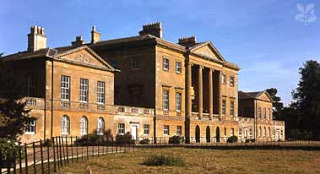 Basildon Park is in Berkshire overlooking the lovely Thames Valley, built in the 1770's in the strict Palladian style by architect John Carr of York.
Basildon Park is in Berkshire overlooking the lovely Thames Valley, built in the 1770's in the strict Palladian style by architect John Carr of York. 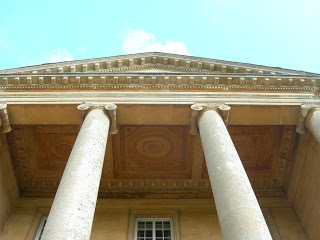 Basildon Park was abandoned about 1910 and stripped of its furnishings even including flooring, fireplace surrounds and woodwork. It was used to house troops or prisoners in both world wars. Some rooms were removed and reconstructed in the Waldorf Astoria Hotel in New York City (ballroom, below).
Basildon Park was abandoned about 1910 and stripped of its furnishings even including flooring, fireplace surrounds and woodwork. It was used to house troops or prisoners in both world wars. Some rooms were removed and reconstructed in the Waldorf Astoria Hotel in New York City (ballroom, below).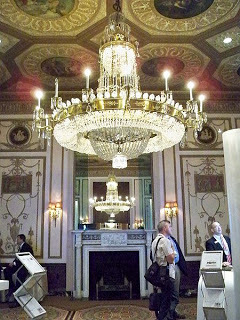 Basildon Park stood mostly empty and deteriorating until 1952 when Lord and Lady Iliffe, a newspaper tycoon and his wife, rescued the house. Lady Iliffe writes, "To say it was derelict is hardly good enough: no window was left intact, and most were repaired with cardboard or plywood; there was a large puddle on the Library floor, coming from the bedroom above, where a fire had just been stopped in time; walls were covered with signatures and graffiti from various occupants….It was appallingly cold and damp. And yet, there was still an atmosphere of former elegance, and a feeling of great solidity. Carr's house was still there, damaged but basically unchanged."
Basildon Park stood mostly empty and deteriorating until 1952 when Lord and Lady Iliffe, a newspaper tycoon and his wife, rescued the house. Lady Iliffe writes, "To say it was derelict is hardly good enough: no window was left intact, and most were repaired with cardboard or plywood; there was a large puddle on the Library floor, coming from the bedroom above, where a fire had just been stopped in time; walls were covered with signatures and graffiti from various occupants….It was appallingly cold and damp. And yet, there was still an atmosphere of former elegance, and a feeling of great solidity. Carr's house was still there, damaged but basically unchanged."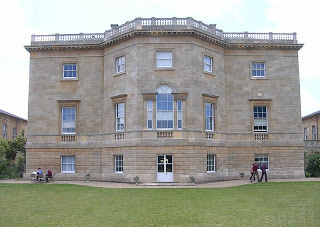 Views of the outside show the Bath stone construction. The Palladian window in the Garden Front is in the Octagon Room.
Views of the outside show the Bath stone construction. The Palladian window in the Garden Front is in the Octagon Room. 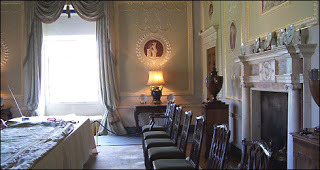 The Iliffes were fortunate enough to find genuine Carr fireplaces and woodwork removed from other houses, mostly in Yorkshire. Carr employed meticulous craftsmen and used standard measurements so that the pieces were virtually interchangeable.
The Iliffes were fortunate enough to find genuine Carr fireplaces and woodwork removed from other houses, mostly in Yorkshire. Carr employed meticulous craftsmen and used standard measurements so that the pieces were virtually interchangeable. 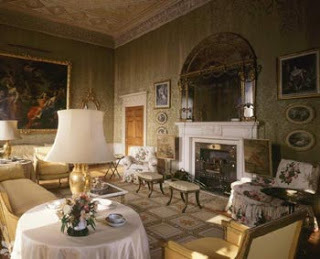 Again, Lady Iliffe: "Carr was such a precise architect that his mahogany doors from Panton (in Lincolnshire) fitted exactly in the sockets of the missing Basildon ones." Thus Basildon is both authentic and a recreation in one.
Again, Lady Iliffe: "Carr was such a precise architect that his mahogany doors from Panton (in Lincolnshire) fitted exactly in the sockets of the missing Basildon ones." Thus Basildon is both authentic and a recreation in one.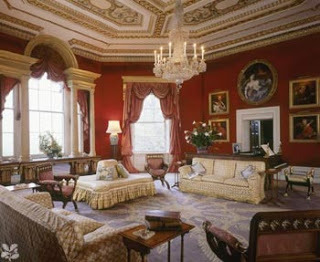
Lady Iliffe collaborated with leading designers of the English Country House style of decorating to fit out the house with a combination of antiques and contemporary pieces, including the inevitable floral chintzes that simply drip with that country house charm. Right, the Octagon Room interior.
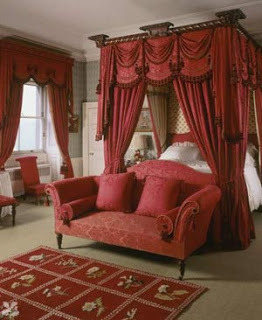 Upstairs the generously sized rooms were adapted to alternating bedrooms and huge bathrooms. It is a bit of a shock to see one of the perfectly proportioned rooms with its decorative plaster ceiling and elaborate woodwork and marble fireplace decked out with nothing more than the finest 1950's plumbing fixtures.
Upstairs the generously sized rooms were adapted to alternating bedrooms and huge bathrooms. It is a bit of a shock to see one of the perfectly proportioned rooms with its decorative plaster ceiling and elaborate woodwork and marble fireplace decked out with nothing more than the finest 1950's plumbing fixtures.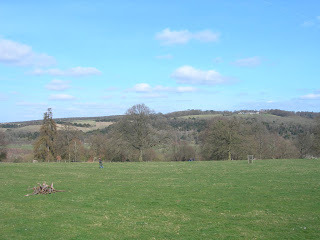 Basildon Park was built between 1776 and 1782 by Sir Francis Sykes, created a baronet in 1781. His roots were in Yorkshire and he chose Carr of York to build his house, a classical Palladian villa with a main block of rooms joined to pavilions on either side. The Sykes fortune was made during his service in India. Right is the view of the countryside.
Basildon Park was built between 1776 and 1782 by Sir Francis Sykes, created a baronet in 1781. His roots were in Yorkshire and he chose Carr of York to build his house, a classical Palladian villa with a main block of rooms joined to pavilions on either side. The Sykes fortune was made during his service in India. Right is the view of the countryside.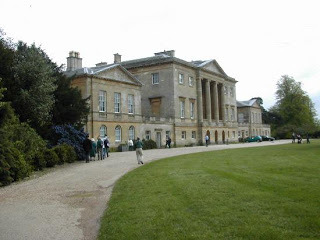 In 1838, the Sykes family sold the house to James Morrison (d. 1857), a Liberal MP who had turned his London haberdashery business into an international concern. By the way, when he was a shopman at Todd and Co., he married his employer's daughter, and eventually took over the firm. Morrison engaged architect John Papworth to design handkerchiefs for his company and later to remodel Basildon. Morrison had acquired a fine collection of paintings and was one of the founding fathers of the National Gallery in London. Papworth worked at Basildon from 1837 to 1842, making some changes to the Octagon Room and other interior designs, all in keeping with the original spirit of Carr's house. Morrison's daughter Miss Ellen Morrison was the last resident before Basildon Park fell into disuse.
In 1838, the Sykes family sold the house to James Morrison (d. 1857), a Liberal MP who had turned his London haberdashery business into an international concern. By the way, when he was a shopman at Todd and Co., he married his employer's daughter, and eventually took over the firm. Morrison engaged architect John Papworth to design handkerchiefs for his company and later to remodel Basildon. Morrison had acquired a fine collection of paintings and was one of the founding fathers of the National Gallery in London. Papworth worked at Basildon from 1837 to 1842, making some changes to the Octagon Room and other interior designs, all in keeping with the original spirit of Carr's house. Morrison's daughter Miss Ellen Morrison was the last resident before Basildon Park fell into disuse.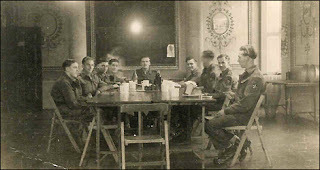 Basildon Park was used to house soldiers during World War II, as were many country houses, and certainly suffered occasional, if not constant, abuse.
Basildon Park was used to house soldiers during World War II, as were many country houses, and certainly suffered occasional, if not constant, abuse.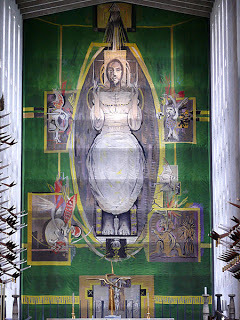 The Iliffes were collectors of the work of the distinguished English artist Graham Sutherland, whose gigantic tapestry adorns the modernist reconstruction of the Coventry Cathedral. (The 14th century cathedral was destroyed in 1940 by German bombs; a modern cathedral was built and filled with works of contemporary art.) A number of Sutherland's paintings and many studies for the tapestry he designed hang at Basildon. The Iliffe family presented the house to the National Trust in 1978.
The Iliffes were collectors of the work of the distinguished English artist Graham Sutherland, whose gigantic tapestry adorns the modernist reconstruction of the Coventry Cathedral. (The 14th century cathedral was destroyed in 1940 by German bombs; a modern cathedral was built and filled with works of contemporary art.) A number of Sutherland's paintings and many studies for the tapestry he designed hang at Basildon. The Iliffe family presented the house to the National Trust in 1978.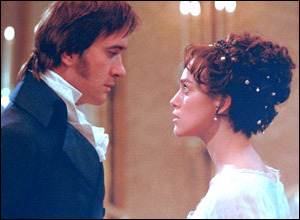 Basildon Park has often served as a set for costume dramas for the BBC and other producers. Here is a scene from the 2005 Pride and Prejudice, where Basildon enacted the role of Netherfield Park.
Basildon Park has often served as a set for costume dramas for the BBC and other producers. Here is a scene from the 2005 Pride and Prejudice, where Basildon enacted the role of Netherfield Park.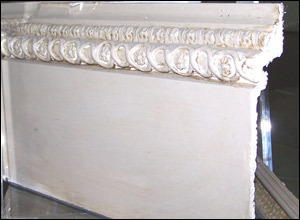 This picture shows how carefully designed temporary baseboards can hide 21th century electrical outlets or cable connections.
This picture shows how carefully designed temporary baseboards can hide 21th century electrical outlets or cable connections.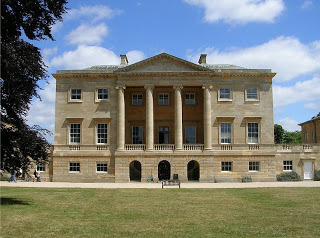
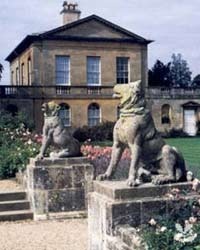
To Basildon Park in Berkshire now in the capable hands of the National Trust, we wish as many more rebirths as necessary to keep out the damp and bring in the tourists.
Remember, Gentle Reader, you can join Kristine and Victoria and experience this fabulous mansion yourself. Please check out all the details at THE WELLINGTON TOUR website.
More detailed reports on Tour Sites to come soon...
Published on October 18, 2013 00:30
October 16, 2013
On The Shelf
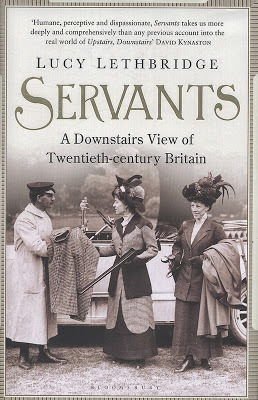
Servants: A Downstairs History of Britain from the Nineteenth Century to Modern Times by Lucy Lethbridge (Norton 2013)
Even if you've been researching daily life in England for years and believe that you know all there is to know about servants by this time, I'm here to tell you that you don't. And you certainly have never had the subject presented in such an entertaining manner. Lethbridge's book is not so much an overview of bygone grandeur and servitude as it is an in-depth and personal look at the people who lived below stairs. Where did they come from? Why did they go into service? What did they think about their `betters' and the other servants in the house? Along with solid facts and figures, Servants sparkles with wit, wisdom and the words of the servants themselves.
As Lethbridge writes - "In 1900 domestic service was still the single largest occupation in Edwardian Britain: of the four million women in the British workforce, a million and a half worked as servants, a majority of them as single-handed maids in small households." The author goes on to introduce the reader to various servants and to provide insight on their backgrounds: "The extent to which Britain’s poor were stunted by disease and malnourishment was made fully apparent after the outbreak of the Second Boer War, when recruiting offices reported that a majority of the working-class recruits were unfit for active service, their diet consisting for the most part of little more than the `staples’ of bread, dripping and tea . . . . Lillian Westall found work as a maid-of-all-work almost impossible: just carting buckets of hot water up and down stairs needed almost the strength of a grown man – and a single maid in a small household would need to carry an estimated three tons of water a week. “This sort of work needed the stamina of an ox and years of semi-starvation meant I hadn’t this sort of strength.”
Lethbridge allows the reader to hear the voices of the aristocrats, as well: "The `odd man,’ a vital fixture on an estate, was a manservant who never quite made the grade required to be a front-of-the-house type and was therefore used for pretty well everything, from carrying heavy luggage to helping with the cleaning. Huge houses could sustain great numbers of the very old and the very young and with their work went the rituals of their particularity, the vital necessity of which no-one thought of questioning. Lady Diana Cooper, who grew up at Belvoir Castle, Rutland, remembered the `gong man’ whose only job was to summon the household to meals by walking the corridors three times a day banging a gong: `He would walk down the interminable passages, his livery hanging a little loosely on his bent old bones, clutching his gong with one hand and with the other feebly brandishing the padded-knobbed stick with which he struck it.'"
Servants provides a peek behind the green baize door with examples of just how extensive, and invisible, the below stairs machinery was - at Belvoir Castle there were at least three lamp and candle men who labored continuously at snuffing wicks, filling lamps and cleaning and de-waxing glass – a full time job. That the great families of England took these labours for granted is made clear, as are the instances in which the same families often declared their loyalties to those who served: at Badminton House, seat of the Duke of Beaufort, the lamp man was totally blind and felt his way expertly about the corridors – and was still doing so in the 1920s. Servants is peppered with further anecdotes that illustrate the peccadilloes and peculiarities of the upper classes, all of which make for an engrossing read.
Halfway through the book, Lethbridge brings us to the early 20th century and to the events - Great Wars, the Industrial Revolution - that would sound the death knells for England's Stately Homes. Slowly, the great estates were losing ground and the previously, seemingly unending line of servants waiting to staff them grew thin. The grandest of these estates were the last to feel the effects.
"At Chatsworth, where thirty indoor staff were employed throughout the 1930's, the only real change in the running of the house after the war was the jettisoning of the ancient role of Groom of Chambers, whose job of looking after the drawing rooms and writing tables was taken over by footmen. Lady Hambleden, born into the Herbert family and brought up at Wilton House before her marriage in 1928, remained almost untouched by the shift, so noticeable in most large houses, from male to female front-of-house staff, from butler to parlourmaid: `We did have quite a lot of staff: there was a butler - I think most people had butlers. I can only think of one person who had parlourmaids and everybody rather noticed it.' "On the Rothschilds' estate, at Waddeston in Buckinghamshire, the gardeners still sent the vegetables to the kitchen door every day in a specially constructed pony cart painted in the Rothschild racing colours of yellow and blue, the coachman who drove it dressed in a matching livery and cockade. At Woburn Abbey, the eleventh Duke of Bedford maintained until his death in 1940 not only a household of at least sixty indoor servants to attend solely to his wife and himself, but two separate, fully staffed residences in Belgrave Square, including four cars and eight chauffeurs; the Woburn parlourmaids were all Amazonian at over five foot ten, as had always been the Bedfords' stipulation."
Whilst it may seem odd to us in the 21st century that so vast an army of servants was necessary to see to the needs of two people, Lethbridge provides many examples that show that, amongst the aristocracy, this was the norm, rather than the exception to the rule. "In the house where Doris Winchester worked, the servants were so numerous that they ate more than twice the daily quantity of their two elderly employers: `If they had roast pheasant in the dining room and there was just the two of them they had one pheasant and I had to do five pheasants for the servants' hall.'" "Holland House was so vast that when George (Washington, a footman) first arrived he was instructed to go to the front door as people had been known to spend `days' searching for the servants' entrance in the maze of courtyards and passages behind. Waiting on Lady Ilchester (we lived there alone) was a butler, a footman, and odd man and second footman, housekeeper and four maids, a stillroom maid, a cook, two kitchen maids and tow scullery maids, a chauffeur, nine gardeners, a lady's maid, a night nurse and a day nurse. The odd man was so old that he was unable to do any heavy work. `When I look back over my three years and a half years at Holland House,' wrote Washington, 'I can see now there was something particularly sad, almost unreal, about them. We were propping up something that belonged to another age, trying to pretend that what had passed still existed or even if it didn't that if we tried hard enough to keep the old order of things going, it might come back.'" The old way of life did not come back, but new ways of life intruded further upon the old order, a case in point being income tax and death duties - "In 1930 a correspondent wrote to The Times: `The result of any increased taxation in my individual case is that I shall have to reduce my servants by half. I now have eight dependent upon me and in order to require good and faithful servants I have made large inroads on capital."
Modernization also intruded upon the aristocracy, who were more often than not slow to embrace it, as in the case of electricity, which many either chose to ignore or else disguised beneath echoes of the past - "This taste for concealing new technology trickled down into the new houses of the middle classes, where the wireless, for example, was often hidden inside an especially constructed cabinet . . . . Sometimes the staff themselves were part of the pretence, maintaining an illusion of elaborate labour where technology had in reality made it redundant. At Flete House, in Devon, the footmen had to remove all the electric table lamps every morning and bring them back in as soon as it grew dark . . . . When electricity was finally installed at Woburn in the late 1920's, the Duke of Bedford believed his guests would be so unaccustomed to this new form of illumination that he had black and white plaques made especially to go above all the switches, inscribed with the explanatory words `Electric Light.'"
Both World Wars also served to upset the old order of things by forcing women into traditionally male work, thus opening doors that led to new employment opportunities for those women who would otherwise have settled for a life in service. Lethbridge uses one of these modern women as an example " . . . In 1939, Celia Fremlin, employed by the new social research group Mass Observation, embarked on a job (for investigative purposes) as scullery-maid for an elderly woman living, bed-bound, in a huge London house. Fremlin's first experience was a surreal experience: That night her aged ladyship had decided to sup on a cup of Benger's food (a malted milk drink, rather like Ovaltine) and a digestive biscuit. So like a vast machine set in motion, the eight members of the staff were mobilized as if for a full-time dinner party. First the housekeeper (1) had to come down to the kitchen to tell the cook that this was to be the menu tonight. Then I, the scullery maid (2) was dispatched to fetch the new tin of Benger's from the store-room, and the special enamel saucepan. I handed them to the kitchen maid (3) who took the lid off and handed the tin to the cook, together with the other necessary apparatus. The cook (4) then set to work making the Benerg's. Now the footman (5) came into action. He went to the butler (6) for the key to the cupboard which contained her ladyship's silver tray. The butler gave him the key and waited while he took out the tray. Then the footman put the tray on his trolley and wheeled it to the kitchen, where the Benger's and digestive biscuit were now standing in state awaiting him. He put them on the tray and wheeled it off to the hall. Here the tray was taken by the head housemaid (7). She took it up to her ladyship's landing and knocked on her ladyship's door. It was opened by the lady's maid (8) who took the tray and disappeared." Fremlin summarized the experience for her employers by writing, "It was like watching a hundred-ton crane picking up a safety-pin; like watching a huge sweet factory producing one peppermint bulls-eye; a vast machine that has forgotten how to stop working." One can't help but wonder of the bed-bound peeress was Lady Ilchester herself. Gradually, the scarcity of good servants began to trickle down to houses of all classes. So prevalent and recognizable did the servant problem become that Elizabeth Dashwood, writing as E.M. Delafield, made a living out of writing a weekly column about them for Time and Tide under the heading Diary of a Provincial Lady. These articles would later be collected and published as a book under that title. As Lethbridge points out, so universal had this problem become that it supplied content for several novelists of the day including Lettice Cooper (The New House) and Mary Wilde (A Housewife in Kensington). From the 1930's onward, refugees began to fill the ranks of the servant classes in England - Austrians, Germans Czechs, both male and female. Many of them, like parlormaid Rachel Perlmutter , a character portrayed in the latest incarnation of Upstairs, Downstairs, were over qualified for their positions, having themselves come from the professional classes in their native countries and often having had servants of their own before entering England. During the Second World War, many of the great houses were requisitioned by the government and the number of servants in homes of any size, large or small, were restricted by the government. With male and female servants having been restricted or having left to fight or take up war work on the home front, evacuees often found themselves expected to sing for their suppers, so to speak, taking up the work that still needed to be done in the houses, the kitchens, the gardens and the farms. The old order would never be the same again. Afterwards, those who took up service, whether as cooks, lady's maids or butlers gradually came to be seen as professionals who were hired through word of mouth, through classified ads or through the many domestic service registry offices that were cropping up around the country. Lethbridge follows the evolution of the those who serve right up to the present day where, quite naturally, the book ends. More's the pity, as Servants was as engaging as any work of fiction whilst proving itself a 'keeper' for my research shelves.
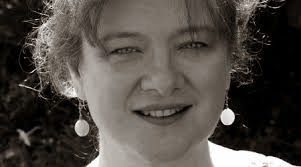 Lucy Lethbridge has written for a number of publications, including as writing articles for the Observer, the Sunday Telegraph, the Independent on Sunday and the Times Literary Supplement and is also the author of several children's books, one of which, Who Was Ada Lovelace?, won the 2002 Blue Peter Award for non-fiction. She lives in London.
Lucy Lethbridge has written for a number of publications, including as writing articles for the Observer, the Sunday Telegraph, the Independent on Sunday and the Times Literary Supplement and is also the author of several children's books, one of which, Who Was Ada Lovelace?, won the 2002 Blue Peter Award for non-fiction. She lives in London.
Published on October 16, 2013 00:00
October 14, 2013
Victoria at Holkham Hall, Part One
I loved Holkham Hall!!! Frankly I had suspected it might be a letdown, an anticlimax after the brilliance of Houghton Hall. I feared the comparison of back-to-back days at two stately homes would disappoint me in the second -- and frankly, I had longed to see Holkham much longer than I yearned for Houghton -- if that makes any sense. But I needn't have worried.
The Holkham Hall Estate website is here.
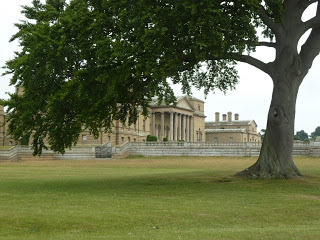 Holkham Hall
Holkham Hall
Magnificent is the word most frequently used to describe Holkham and the building surely lives up to its reputation as among the finest Palladian buildings in the realm. And it has the added attraction of having been the home of a distinguished English gentleman, Thomas William Coke (1754-1842), MP and agricultural innovator, later named (at age 83) to the revived title of the Earl of Leicester of Holkham.
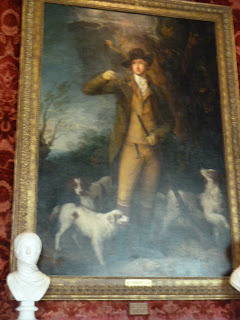 portrait of Thomas William Coke (pronounced Cook)
portrait of Thomas William Coke (pronounced Cook)
I admit that one of my favorite things about Holkham is that pictures are allowed everywhere. I find it hard to understand why people restrict taking pictures of their premises, whether stately homes, museums, or whatever, as today's digital cameras usually don't need flash. Seems needlessly restrictive. Of course, when pictures are allowed, some people (moi?) will take too many! As of the incredible Marble Hall, just inside the entrance to Holkham Hall.
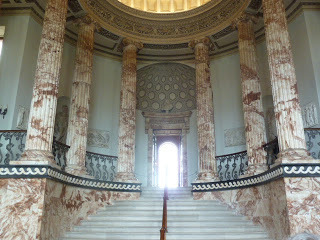
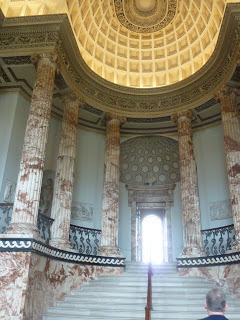
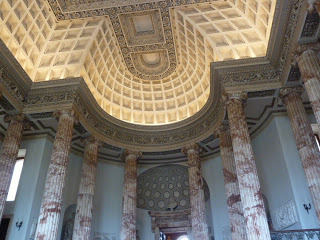
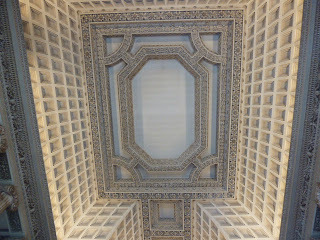 50+ foot ceiling
50+ foot ceiling
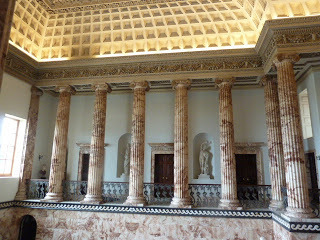 I really found it hard to stop finding new perspectives to snap. I really needed a wide-angle lens, didn't I? Even though it is named Marble Hall, the material used was actually Derbyshire Alabaster.
I really found it hard to stop finding new perspectives to snap. I really needed a wide-angle lens, didn't I? Even though it is named Marble Hall, the material used was actually Derbyshire Alabaster.
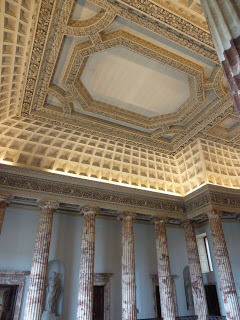
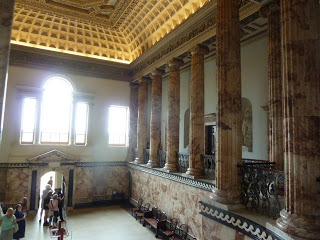 Visitors entering Holkham Hall
Visitors entering Holkham Hall
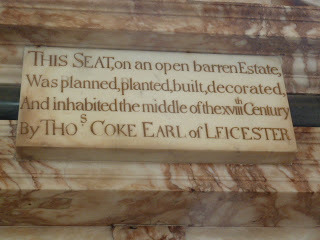 Over the door, Lady Leicester placed this sign, referring toThomas Coke, the great-uncle of Coke of Norfolk; they shared the same name and title Sometimes it can be confusing as to which Thomas Cook, Earl of Leicester, is which.
Over the door, Lady Leicester placed this sign, referring toThomas Coke, the great-uncle of Coke of Norfolk; they shared the same name and title Sometimes it can be confusing as to which Thomas Cook, Earl of Leicester, is which.
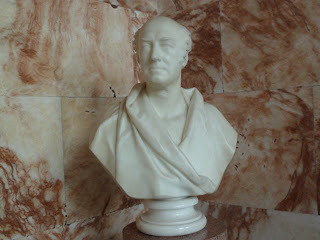 A Marble Bust of Coke of Norfolk
A Marble Bust of Coke of Norfolk
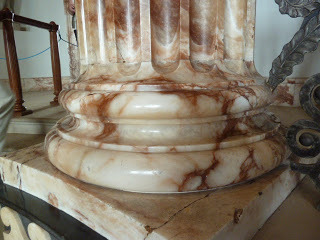 Column Base, of Derbyshire Alabaster The family fortune was founded in the time of Henry VIII by Sir Edward Coke (1552-1634), Lord Chief Justice in the reign of James I. A century later, Sir Edward's descendant Thomas Coke (1697–1759) built Holkham Hall for his family and to house his collection of art acquired on his grand tour; he was created lst Earl of Leicester of the Fifth Creation in 1744. Since his only son died young, the heir to Holkham Hall was his nephew Wenman Coke, father of Thomas William Coke.
Column Base, of Derbyshire Alabaster The family fortune was founded in the time of Henry VIII by Sir Edward Coke (1552-1634), Lord Chief Justice in the reign of James I. A century later, Sir Edward's descendant Thomas Coke (1697–1759) built Holkham Hall for his family and to house his collection of art acquired on his grand tour; he was created lst Earl of Leicester of the Fifth Creation in 1744. Since his only son died young, the heir to Holkham Hall was his nephew Wenman Coke, father of Thomas William Coke.
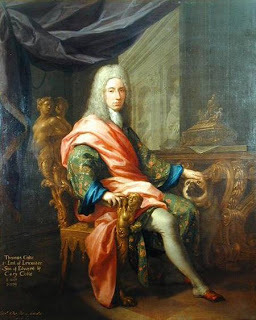 Thomas Coke, ca. 1715, painted by Francesco Trevisani (1656–1746), in Italy The Thomas Coke above shared many experiences and concepts with the men responsible for the Palladian "revolution" in England in the early to mid 18th century, from their days on the Grand Tour: Richard Boyle, 3rd Earl of Burlington (1694–1753); architect Colen Campbell (1676–1729) author of Vitruvius Britannicus, or the British Architect 1715-1725; and William Kent (c.1685–1748), architect and furniture designer, among others. These men were also largely responsible for nearby Houghton Hall, visited in the two previous posts in this series.
Thomas Coke, ca. 1715, painted by Francesco Trevisani (1656–1746), in Italy The Thomas Coke above shared many experiences and concepts with the men responsible for the Palladian "revolution" in England in the early to mid 18th century, from their days on the Grand Tour: Richard Boyle, 3rd Earl of Burlington (1694–1753); architect Colen Campbell (1676–1729) author of Vitruvius Britannicus, or the British Architect 1715-1725; and William Kent (c.1685–1748), architect and furniture designer, among others. These men were also largely responsible for nearby Houghton Hall, visited in the two previous posts in this series.
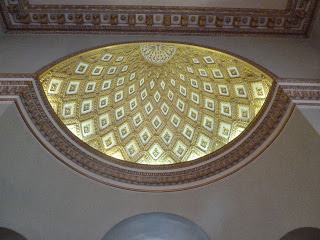 Holkham Hall 'Palladian' refers to the architecture of Andrea Palladio (1508–1580), whose work in the Veneto region of Italy was based on the principles of proportion and symmetry of ancient Greek and Roman temples. A brief taste of this style appeared in England in the work of Inigo Jones (1573–1652), but was not revived until long after the Civil War was over in 1660 (e.g. the Banqueting House, Whitehall; The Queen's House, Greenwich; and Covent Garden's St. Paul's Church). After the 1st Earl of Leicester died in 1759, his widow lived at Holkham until her death in 1775. The estate then passed to the nephew Wenman, who lived there for only a few months before dying in 1776. His son, Thomas William Coke (the future Coke of Norfolk) thus inherited the Holkham estate at age 22, after taking the Grand Tour. Coke of Norfolk grew up on his father Wenman Roberts Coke's estate in Derbyshire, much smaller than Holkham, but a good grounding for a man who dedicated his life to agriculture -- and to political affairs.
Holkham Hall 'Palladian' refers to the architecture of Andrea Palladio (1508–1580), whose work in the Veneto region of Italy was based on the principles of proportion and symmetry of ancient Greek and Roman temples. A brief taste of this style appeared in England in the work of Inigo Jones (1573–1652), but was not revived until long after the Civil War was over in 1660 (e.g. the Banqueting House, Whitehall; The Queen's House, Greenwich; and Covent Garden's St. Paul's Church). After the 1st Earl of Leicester died in 1759, his widow lived at Holkham until her death in 1775. The estate then passed to the nephew Wenman, who lived there for only a few months before dying in 1776. His son, Thomas William Coke (the future Coke of Norfolk) thus inherited the Holkham estate at age 22, after taking the Grand Tour. Coke of Norfolk grew up on his father Wenman Roberts Coke's estate in Derbyshire, much smaller than Holkham, but a good grounding for a man who dedicated his life to agriculture -- and to political affairs.
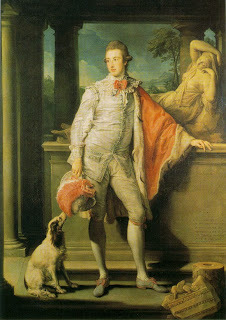 Thomas William Coke, 1774, by Pompeo Batoni (1708–1787) Thomas William Coke did little to change the grand house of his esteemed great uncle. Instead, he turned his considerable energies to agriculture and politics. He served in the House of Commons for many years, aligning himself mostly with the great land owners in the Whig Party. He was an M.P. for Norfolk from 1776-1784, then again represented Norfolk between 1790 and 1832.
Thomas William Coke, 1774, by Pompeo Batoni (1708–1787) Thomas William Coke did little to change the grand house of his esteemed great uncle. Instead, he turned his considerable energies to agriculture and politics. He served in the House of Commons for many years, aligning himself mostly with the great land owners in the Whig Party. He was an M.P. for Norfolk from 1776-1784, then again represented Norfolk between 1790 and 1832.
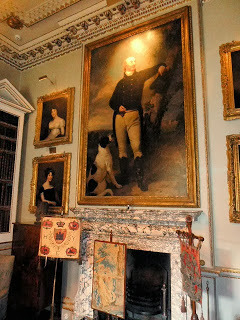 Coke of Norfolk by Ramsay Richard Reinagle, 1815 Thomas William Coke's first wife was Jane Dutton (1753-1800) with whom he had three daughters, Ladies Jane, Anne, and Elizabeth. After his wife's death, Coke was a widower for many years. At the age of 68 in 1822 he married Lady Anne Keppel (1803-1844), age eighteen. This September-May union led to the birth of several more children, including a male heir, Thomas William Coke (1822-1909), who became the second Earl of Leicester of the second creation.
Coke of Norfolk by Ramsay Richard Reinagle, 1815 Thomas William Coke's first wife was Jane Dutton (1753-1800) with whom he had three daughters, Ladies Jane, Anne, and Elizabeth. After his wife's death, Coke was a widower for many years. At the age of 68 in 1822 he married Lady Anne Keppel (1803-1844), age eighteen. This September-May union led to the birth of several more children, including a male heir, Thomas William Coke (1822-1909), who became the second Earl of Leicester of the second creation.
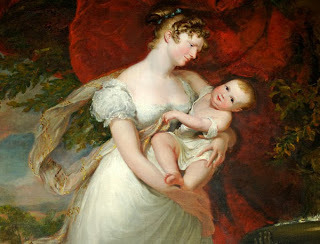 Lady Anne Coke, Countess of Leicester, and son Thomas, b. 1822
Lady Anne Coke, Countess of Leicester, and son Thomas, b. 1822
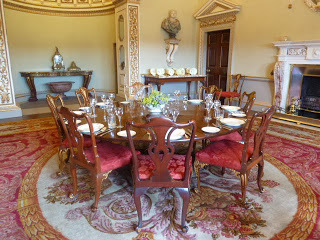 North State Dining Room
North State Dining Room
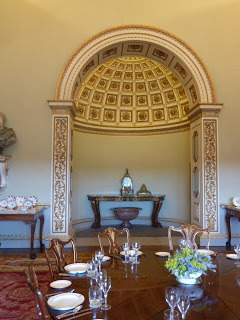 North State Dining Room The Guidebook to Holkham Hall describes this room as having "austere splendor" but I must say I'd rather have dinner with the Earl at this lovely round table than at a long narrow one. Unfortunately our invitation got lost in the mail. Truly a pity.
North State Dining Room The Guidebook to Holkham Hall describes this room as having "austere splendor" but I must say I'd rather have dinner with the Earl at this lovely round table than at a long narrow one. Unfortunately our invitation got lost in the mail. Truly a pity.
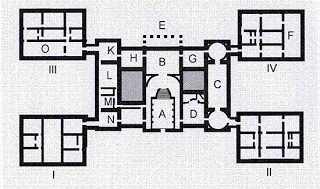 Plan of Holkham Hall The Marble Hall is A in the plan above, the North Dining Room is D. The Saloon, below is B.
Plan of Holkham Hall The Marble Hall is A in the plan above, the North Dining Room is D. The Saloon, below is B.
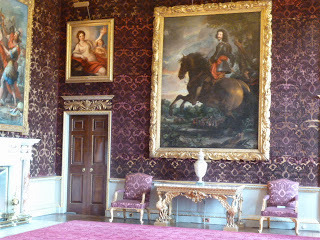 The Saloon Among the brilliant paintings in the house, the Van Dyke equestrian portrait of the Duc d'Arenberg is one of the most famous. Below is the doorway into the Marble Hall from the Saloon.
The Saloon Among the brilliant paintings in the house, the Van Dyke equestrian portrait of the Duc d'Arenberg is one of the most famous. Below is the doorway into the Marble Hall from the Saloon.
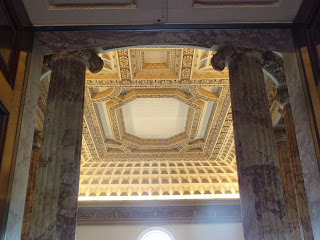 Looking into the Marble Hall from the Saloon
Looking into the Marble Hall from the Saloon
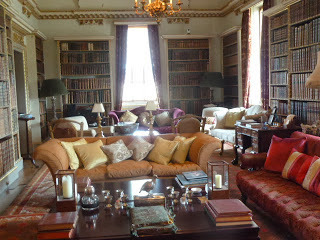 The inviting Library in the Family Wing (F)
The inviting Library in the Family Wing (F)
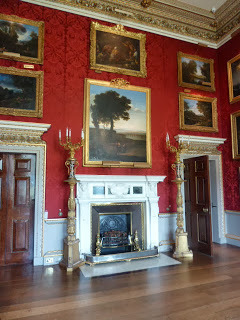 The Landscape Room (K) Most of these priceless paintings were originally purchased by (the first) Thomas Coke on his Grand Tour. Included are works by Poussin, Claude, Grimaldi, Rosa, and others.
The Landscape Room (K) Most of these priceless paintings were originally purchased by (the first) Thomas Coke on his Grand Tour. Included are works by Poussin, Claude, Grimaldi, Rosa, and others.
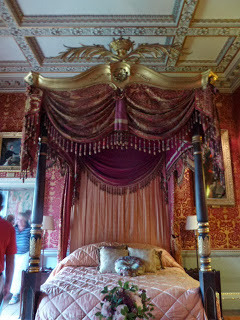 The Stunning Parrot Bedroom
The Stunning Parrot Bedroom
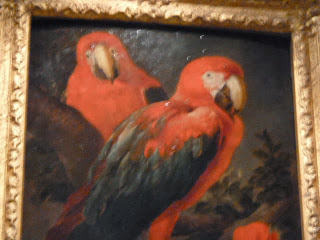 The Parrots, for whom the room is named
The Parrots, for whom the room is named
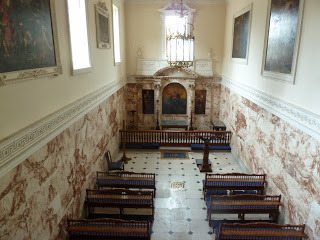 The handsome Chapel (O)
The handsome Chapel (O)
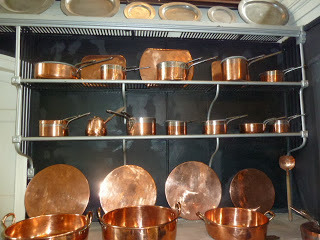 Stunning Cooper pans and bowls
Stunning Cooper pans and bowls
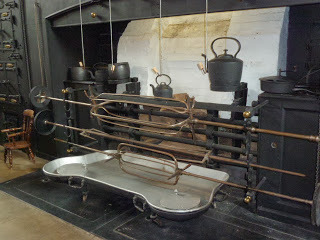 The gigantic kitchen fireplace, large enough to roast an ox I have run out of superlatives to describe the interior of Holkham Hall, so I will close for the time being, and leave a few more features of the estate for Part Two, coming soon.
The gigantic kitchen fireplace, large enough to roast an ox I have run out of superlatives to describe the interior of Holkham Hall, so I will close for the time being, and leave a few more features of the estate for Part Two, coming soon.
The Holkham Hall Estate website is here.
 Holkham Hall
Holkham Hall Magnificent is the word most frequently used to describe Holkham and the building surely lives up to its reputation as among the finest Palladian buildings in the realm. And it has the added attraction of having been the home of a distinguished English gentleman, Thomas William Coke (1754-1842), MP and agricultural innovator, later named (at age 83) to the revived title of the Earl of Leicester of Holkham.
 portrait of Thomas William Coke (pronounced Cook)
portrait of Thomas William Coke (pronounced Cook)I admit that one of my favorite things about Holkham is that pictures are allowed everywhere. I find it hard to understand why people restrict taking pictures of their premises, whether stately homes, museums, or whatever, as today's digital cameras usually don't need flash. Seems needlessly restrictive. Of course, when pictures are allowed, some people (moi?) will take too many! As of the incredible Marble Hall, just inside the entrance to Holkham Hall.



 50+ foot ceiling
50+ foot ceiling I really found it hard to stop finding new perspectives to snap. I really needed a wide-angle lens, didn't I? Even though it is named Marble Hall, the material used was actually Derbyshire Alabaster.
I really found it hard to stop finding new perspectives to snap. I really needed a wide-angle lens, didn't I? Even though it is named Marble Hall, the material used was actually Derbyshire Alabaster.

 Visitors entering Holkham Hall
Visitors entering Holkham Hall
 Over the door, Lady Leicester placed this sign, referring toThomas Coke, the great-uncle of Coke of Norfolk; they shared the same name and title Sometimes it can be confusing as to which Thomas Cook, Earl of Leicester, is which.
Over the door, Lady Leicester placed this sign, referring toThomas Coke, the great-uncle of Coke of Norfolk; they shared the same name and title Sometimes it can be confusing as to which Thomas Cook, Earl of Leicester, is which.
 A Marble Bust of Coke of Norfolk
A Marble Bust of Coke of Norfolk
 Column Base, of Derbyshire Alabaster The family fortune was founded in the time of Henry VIII by Sir Edward Coke (1552-1634), Lord Chief Justice in the reign of James I. A century later, Sir Edward's descendant Thomas Coke (1697–1759) built Holkham Hall for his family and to house his collection of art acquired on his grand tour; he was created lst Earl of Leicester of the Fifth Creation in 1744. Since his only son died young, the heir to Holkham Hall was his nephew Wenman Coke, father of Thomas William Coke.
Column Base, of Derbyshire Alabaster The family fortune was founded in the time of Henry VIII by Sir Edward Coke (1552-1634), Lord Chief Justice in the reign of James I. A century later, Sir Edward's descendant Thomas Coke (1697–1759) built Holkham Hall for his family and to house his collection of art acquired on his grand tour; he was created lst Earl of Leicester of the Fifth Creation in 1744. Since his only son died young, the heir to Holkham Hall was his nephew Wenman Coke, father of Thomas William Coke.
 Thomas Coke, ca. 1715, painted by Francesco Trevisani (1656–1746), in Italy The Thomas Coke above shared many experiences and concepts with the men responsible for the Palladian "revolution" in England in the early to mid 18th century, from their days on the Grand Tour: Richard Boyle, 3rd Earl of Burlington (1694–1753); architect Colen Campbell (1676–1729) author of Vitruvius Britannicus, or the British Architect 1715-1725; and William Kent (c.1685–1748), architect and furniture designer, among others. These men were also largely responsible for nearby Houghton Hall, visited in the two previous posts in this series.
Thomas Coke, ca. 1715, painted by Francesco Trevisani (1656–1746), in Italy The Thomas Coke above shared many experiences and concepts with the men responsible for the Palladian "revolution" in England in the early to mid 18th century, from their days on the Grand Tour: Richard Boyle, 3rd Earl of Burlington (1694–1753); architect Colen Campbell (1676–1729) author of Vitruvius Britannicus, or the British Architect 1715-1725; and William Kent (c.1685–1748), architect and furniture designer, among others. These men were also largely responsible for nearby Houghton Hall, visited in the two previous posts in this series.
 Holkham Hall 'Palladian' refers to the architecture of Andrea Palladio (1508–1580), whose work in the Veneto region of Italy was based on the principles of proportion and symmetry of ancient Greek and Roman temples. A brief taste of this style appeared in England in the work of Inigo Jones (1573–1652), but was not revived until long after the Civil War was over in 1660 (e.g. the Banqueting House, Whitehall; The Queen's House, Greenwich; and Covent Garden's St. Paul's Church). After the 1st Earl of Leicester died in 1759, his widow lived at Holkham until her death in 1775. The estate then passed to the nephew Wenman, who lived there for only a few months before dying in 1776. His son, Thomas William Coke (the future Coke of Norfolk) thus inherited the Holkham estate at age 22, after taking the Grand Tour. Coke of Norfolk grew up on his father Wenman Roberts Coke's estate in Derbyshire, much smaller than Holkham, but a good grounding for a man who dedicated his life to agriculture -- and to political affairs.
Holkham Hall 'Palladian' refers to the architecture of Andrea Palladio (1508–1580), whose work in the Veneto region of Italy was based on the principles of proportion and symmetry of ancient Greek and Roman temples. A brief taste of this style appeared in England in the work of Inigo Jones (1573–1652), but was not revived until long after the Civil War was over in 1660 (e.g. the Banqueting House, Whitehall; The Queen's House, Greenwich; and Covent Garden's St. Paul's Church). After the 1st Earl of Leicester died in 1759, his widow lived at Holkham until her death in 1775. The estate then passed to the nephew Wenman, who lived there for only a few months before dying in 1776. His son, Thomas William Coke (the future Coke of Norfolk) thus inherited the Holkham estate at age 22, after taking the Grand Tour. Coke of Norfolk grew up on his father Wenman Roberts Coke's estate in Derbyshire, much smaller than Holkham, but a good grounding for a man who dedicated his life to agriculture -- and to political affairs.
 Thomas William Coke, 1774, by Pompeo Batoni (1708–1787) Thomas William Coke did little to change the grand house of his esteemed great uncle. Instead, he turned his considerable energies to agriculture and politics. He served in the House of Commons for many years, aligning himself mostly with the great land owners in the Whig Party. He was an M.P. for Norfolk from 1776-1784, then again represented Norfolk between 1790 and 1832.
Thomas William Coke, 1774, by Pompeo Batoni (1708–1787) Thomas William Coke did little to change the grand house of his esteemed great uncle. Instead, he turned his considerable energies to agriculture and politics. He served in the House of Commons for many years, aligning himself mostly with the great land owners in the Whig Party. He was an M.P. for Norfolk from 1776-1784, then again represented Norfolk between 1790 and 1832.
 Coke of Norfolk by Ramsay Richard Reinagle, 1815 Thomas William Coke's first wife was Jane Dutton (1753-1800) with whom he had three daughters, Ladies Jane, Anne, and Elizabeth. After his wife's death, Coke was a widower for many years. At the age of 68 in 1822 he married Lady Anne Keppel (1803-1844), age eighteen. This September-May union led to the birth of several more children, including a male heir, Thomas William Coke (1822-1909), who became the second Earl of Leicester of the second creation.
Coke of Norfolk by Ramsay Richard Reinagle, 1815 Thomas William Coke's first wife was Jane Dutton (1753-1800) with whom he had three daughters, Ladies Jane, Anne, and Elizabeth. After his wife's death, Coke was a widower for many years. At the age of 68 in 1822 he married Lady Anne Keppel (1803-1844), age eighteen. This September-May union led to the birth of several more children, including a male heir, Thomas William Coke (1822-1909), who became the second Earl of Leicester of the second creation.  Lady Anne Coke, Countess of Leicester, and son Thomas, b. 1822
Lady Anne Coke, Countess of Leicester, and son Thomas, b. 1822
 North State Dining Room
North State Dining Room
 North State Dining Room The Guidebook to Holkham Hall describes this room as having "austere splendor" but I must say I'd rather have dinner with the Earl at this lovely round table than at a long narrow one. Unfortunately our invitation got lost in the mail. Truly a pity.
North State Dining Room The Guidebook to Holkham Hall describes this room as having "austere splendor" but I must say I'd rather have dinner with the Earl at this lovely round table than at a long narrow one. Unfortunately our invitation got lost in the mail. Truly a pity.
 Plan of Holkham Hall The Marble Hall is A in the plan above, the North Dining Room is D. The Saloon, below is B.
Plan of Holkham Hall The Marble Hall is A in the plan above, the North Dining Room is D. The Saloon, below is B.
 The Saloon Among the brilliant paintings in the house, the Van Dyke equestrian portrait of the Duc d'Arenberg is one of the most famous. Below is the doorway into the Marble Hall from the Saloon.
The Saloon Among the brilliant paintings in the house, the Van Dyke equestrian portrait of the Duc d'Arenberg is one of the most famous. Below is the doorway into the Marble Hall from the Saloon.
 Looking into the Marble Hall from the Saloon
Looking into the Marble Hall from the Saloon
 The inviting Library in the Family Wing (F)
The inviting Library in the Family Wing (F)
 The Landscape Room (K) Most of these priceless paintings were originally purchased by (the first) Thomas Coke on his Grand Tour. Included are works by Poussin, Claude, Grimaldi, Rosa, and others.
The Landscape Room (K) Most of these priceless paintings were originally purchased by (the first) Thomas Coke on his Grand Tour. Included are works by Poussin, Claude, Grimaldi, Rosa, and others.
 The Stunning Parrot Bedroom
The Stunning Parrot Bedroom
 The Parrots, for whom the room is named
The Parrots, for whom the room is named
 The handsome Chapel (O)
The handsome Chapel (O)
 Stunning Cooper pans and bowls
Stunning Cooper pans and bowls
 The gigantic kitchen fireplace, large enough to roast an ox I have run out of superlatives to describe the interior of Holkham Hall, so I will close for the time being, and leave a few more features of the estate for Part Two, coming soon.
The gigantic kitchen fireplace, large enough to roast an ox I have run out of superlatives to describe the interior of Holkham Hall, so I will close for the time being, and leave a few more features of the estate for Part Two, coming soon.
Published on October 14, 2013 00:30
Kristine Hughes's Blog
- Kristine Hughes's profile
- 6 followers
Kristine Hughes isn't a Goodreads Author
(yet),
but they
do have a blog,
so here are some recent posts imported from
their feed.



